German Karlsruhe, F212, 1:300 scale Revell Kit #5143, F122 Breman Class OOB Review and Build
My Review and Build of Revell KIT #5143, Bremen Class, 1/300 SCALE F122 Frigate, Karlsruhe, F212 REVIEW & BUILD,
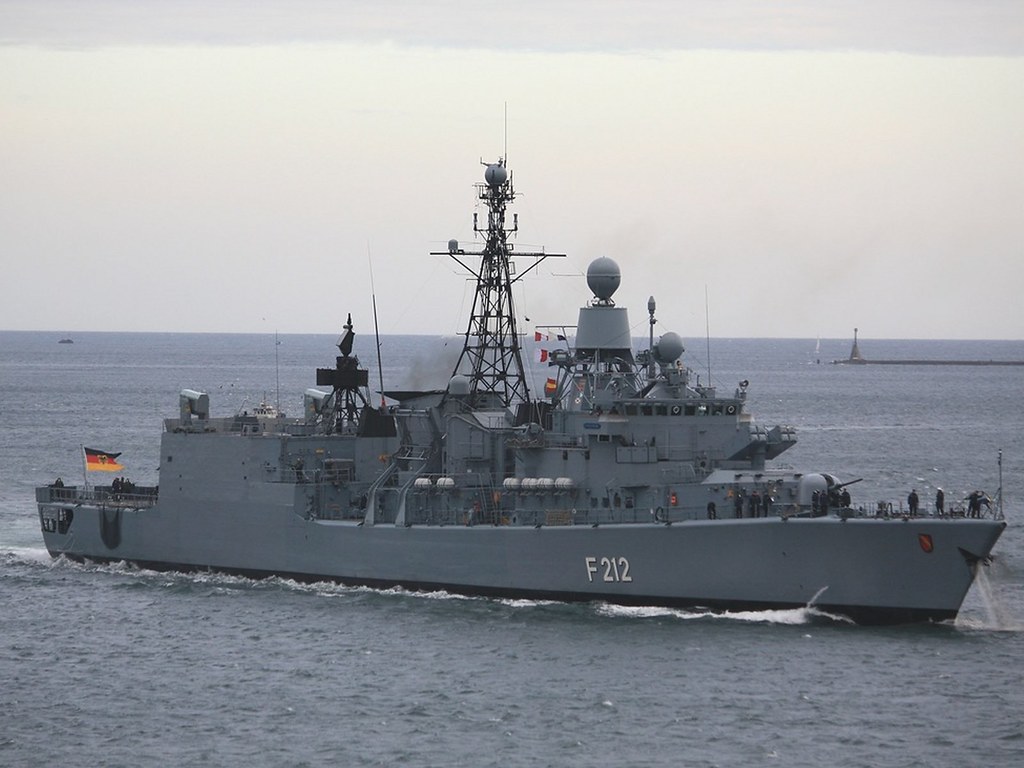
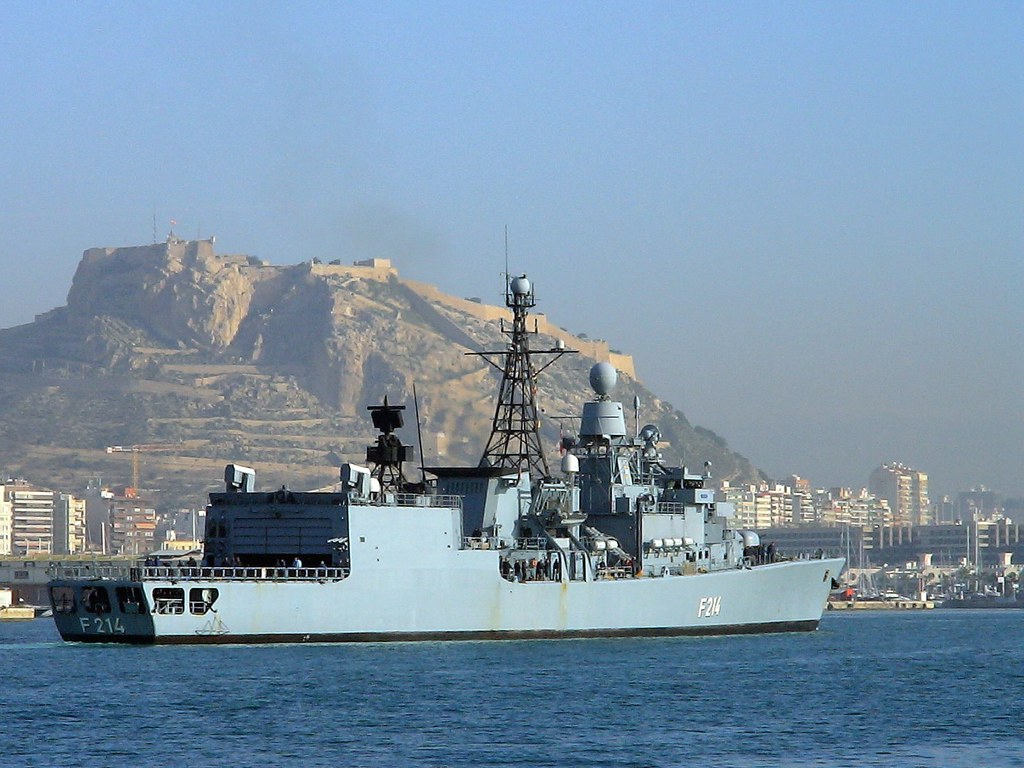
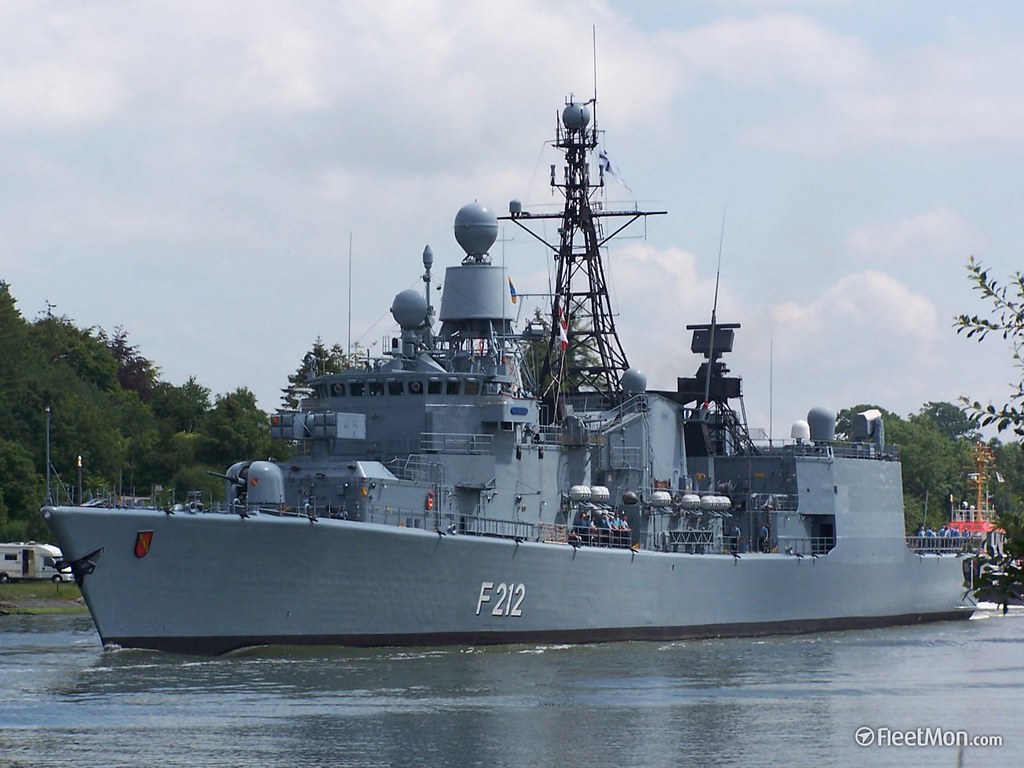
German Type F122 Bremen Class Friagtes
A total of eight F122 Bremen-class frigates of the German Navy were commissioned between 1982 and 1990. These have been the main stay of German frigates for the last 30 years, and they were built to a similar design as the Dutch Kortenaer class but with a different hull and propulsion system. The ships were built primarily for anti-submarine warfare but are also suited for multi-role tasks of anti-aircraft warfare and anti-surface warfare.
This class of ship was one of the last to be constructed under post-war displacement limitations imposed by the west on West Germany after World War II. Just the same, they are capable frigates, handle well, and have seved very capably for 30 and more years.
The eight Bremen class frigates will are in the process of being replaced by the new, much larger, more stealthy, F125 Baden-Württemberg class frigates, of which the first two have already been launched.
The charateristics of these frigates are as follows:
Displacement: 3,680 tonnes (3,620 long tons)
Length: 130.50 m (428 ft 2 in)
Beam: 14.60 m (47 ft 11 in)
Draft: 6.30 m (20 ft 8 in)
Propulsion: 2 × propeller shafts, controllable pitch, five-bladed Sulzer-Escher propellers, later replaced with seven-bladed
CODOG (Combined diesel or gas)
- 2 × MTU 20V956 TB92 diesel engines, 8.14 MW (10,920 hp) total
- 2 × General Electric LM2500 gas turbines, 38 MW (51,000 hp) total
- 2 × Renk STG 150-50 gearboxes, 10:1 (diesel) and 720:47 (turbine)
- 4 × Deutz MWM diesel-generators, 750 kW (1,010 hp)
Speed: 30 knots (56 km/h)
Range: more than 4,000 nmi (7,400 km) at 18 knots (33 km/h)
Complement: 202 crew plus 20 aviation
Sensors and processing systems:
1 × EADS TRS-3D air search radar (three-dimensional)
1 × WM 25 combined surface search and fire control radar I/J band
1 × Thales Nederland STIR 180 fire-control radar I/J/K band
1 × Kelvin Hughes Nucleus 5000 I band navigation radar
1 × STN Atlas DSQS-23BZ hull-mounted sonar
Electronic warfare & decoys:
ESM/ECM EADS FL 1800S
2 × SCLAR decoys
SLQ-25 Nixie torpedo decoy
Armament:
Naval guns:
1 × OTO-Melara 76 mm dual-purpose gun
2 × Mauser MLG27 27 mm autocannons
Antiaircraft warfare:
1 × 8-cell launch system, 16 × Sea Sparrow surface to air missiles
CIWS:
2 × MK 49 launcher, 21 × RAM each
Anti-ship missiles:
2 × quadruple Harpoon anti-ship missile launchers
Antisubmarine warfare:
2 × Mark 32 324-mm twin torpedo launchers, 8 × DM4A1 or Mark 46 torpedo Aircraft carried:
2 Sea Lynx Mk.88A helicopters equipped with torpedoes, air-to-surface missiles Sea Skua, and/or heavy machine gun.
Some of the major design goals in building these vessels in the 1990s were, reduced radar, infrared and acoustic signatures (stealth technology), something that was new to the German Navy but has since been even more enhanced successively with the Type 123 Brandenburg-class frigate, the Type F124 Sachsen-class frigate, and now most notably with the new Type F125 Baden-Württemberg-class frigates.
Other important requirements in the 1980s, for frigates designed for the cold war, were to escort convoys for reinforcement and resupply of Allied forces in Europe. They frequently took part in NATO Standing Naval Forces. Since 1990, all ships have served in additional supporting missions such as the embargo operations against former Yugoslavia in the Adriatic Sea or Operation Enduring Freedom against the international terrorism.
During their lifetime, the ships' equipment has frequently been modernized and a further adaptation of combat systems is foreseen in the near future.
The Karlsruhe, F212
The Karlsruhe is the sixt of the class of eight Breen Class F122 frigates. She was laid down March 10, 1981, launched on January 8, 1982, and commission on April 19, 1984. She has been in active service for 33 years now.
For a period of time, Karlsruhe wa fitted with an addition Close-in-Weapon-System (CIWS) which was a 30mm Goal keeper 30mm gatlin gun for shooting down missile or other air threats. But the two RAM (Rolling air-frame missile) launchers were deamed more effective, and these two have been, with their 21 missiles each (412 missiles together) aboard all of the Bremen class since the mid-1980s.
During the Cold War period, up until 1990 or 1991, the ships' main war task was to escort convoys for reinforcement and resupply of Allied forces in Europe in case of war with the Soviet Union.
Once the Soviet Union fell and wnt bankrupt, the frigates have also taken on duties of crisis management with various caris cinluding Yugoslavia, Serbia, Lybia, the Mid-East with Iraq and Syria, and other such duties. These vessels, including the Karlsruhe, frequently take part in NATO Standing Naval Forces.
In fact, in 2016, the Karlsruhe was named the flagship of Standing NATO Maritime Group 2 (SNMG2) patrolling the Aegean Sea.
Since 1990, all ships have served in additional supporting missions such as the embargo operations against former Yugoslavia in the Adriatic Sea or Operation Enduring Freedom against the international terrorism.
The Karlsruhe has also successfully assisted in pirating operation in the Gulf of Aden. On December 25, 2008, she actively particpated asssiting an Egyptian freighter repel pirates on that date in the Gulf of Aden.
During her lifetime, as with all of the Bremen class, Karlsruhe, has frequently been modernized and with further adaptations of combat systems.
Karlsrruhe is one of only three Bremen class left in active service. It expected that she or one of her sisters will be decommissioned with the launch and trails of he next F125 frigate.
Introduction and What's in the Box - February 18, 2016
This Revell kit is from the GErman Operation group for revell. It is molded to scael 1/300. Although the most common scale is 1/350, revell models several ships in 1/35, and this is the only known injected molded plastic model of the F122, Bremen lass known.
The model is well done with numrous sprues of parts.
There is no "water-line" option and the hull comes in to pieces, port and starboard halves.
The kit includes all of the railing, but it is bulky plastic moled railing and larger than the actual raiing would be. I have a significant amount of 1/350 scale photo etch metal railing and will use it for this kit instead of what comes with the model.
Another short coming is the weapon systems. The Sea Sparrow Luancher, the RAM launchers, and the Harpoon missile launchers are all extremely simplistic with very little detail.
I have some Veteran model RAM launchers and ome very nice Harpoon quad launchers from other model kits, and also have Sea Sparrow missile covers for the octuple launcher to add realism to those parts...all of which I will use in this model.
There is also quite a bit of flash that needs to be removed from the model parts as you remove them from the sprues.
All of that said, themodel is a decent depiction of the class, and includes decals for any of the class. THis was a nice feature as I specificaly wanted to build the KArlsruhe.
Back in the mid-1970s I spent two years in Germany serving a mission for my church. During my time there I lived 10 months in Karlsruhe and really liked the there on the Rhine and the French border. So I wanted specifically to build the LArlsruhe since I feel a kinship to that city and a number of good people I met and befriended there.
The instructions are very nice in a 16 page full color booklet, with full color illustrations of the painting scheme.
I believe with the additional parts I am using and the photo etch parts, that this model will turn out ery well.
Here's how the model looks from the box, with the instructions:
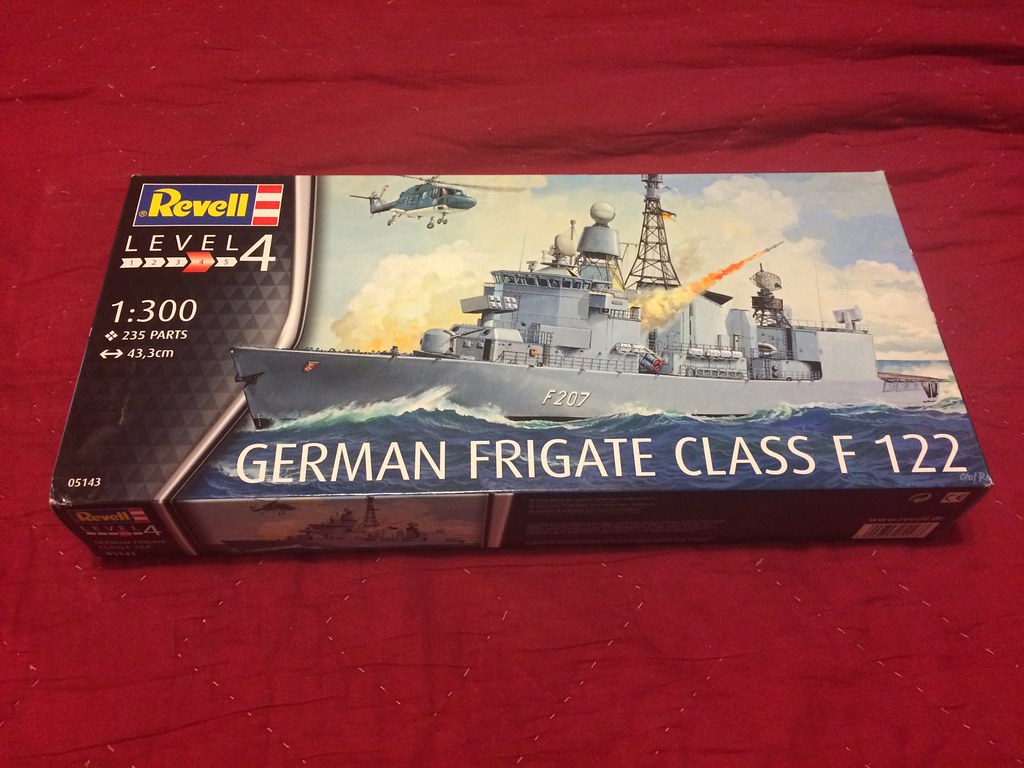
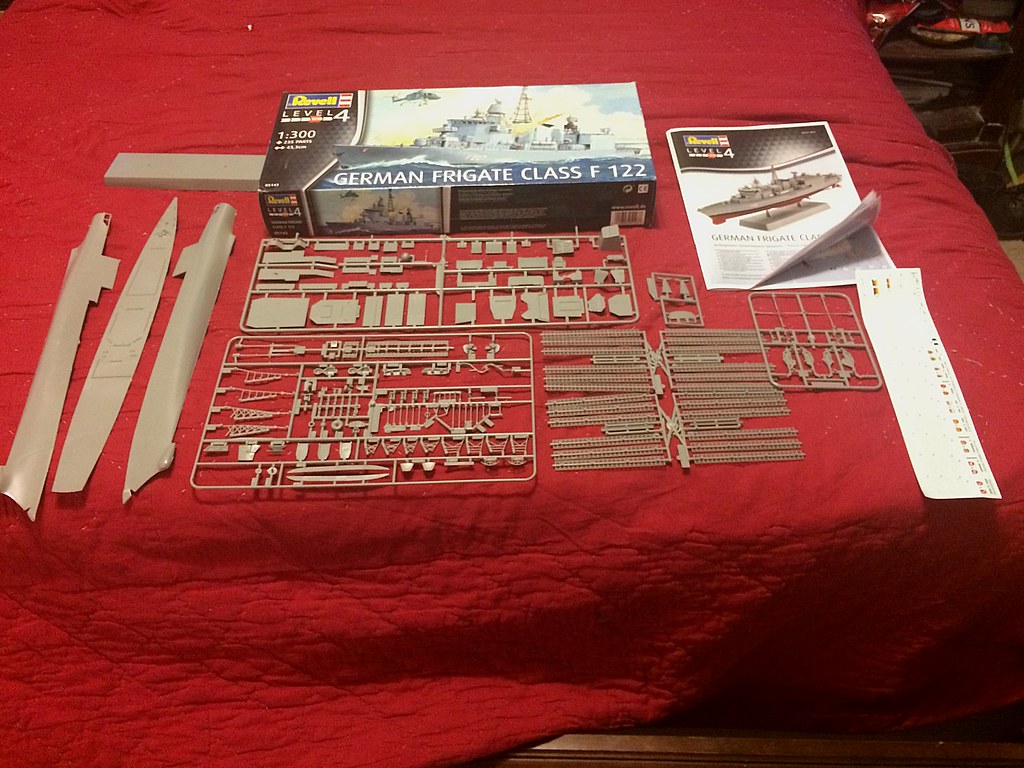
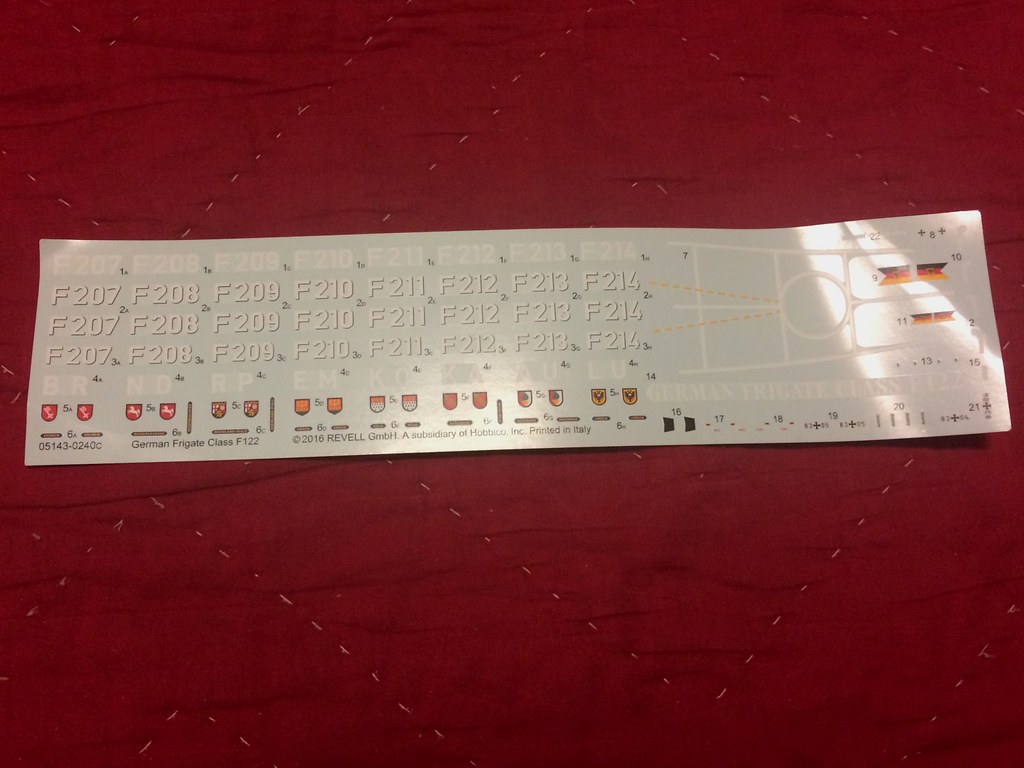
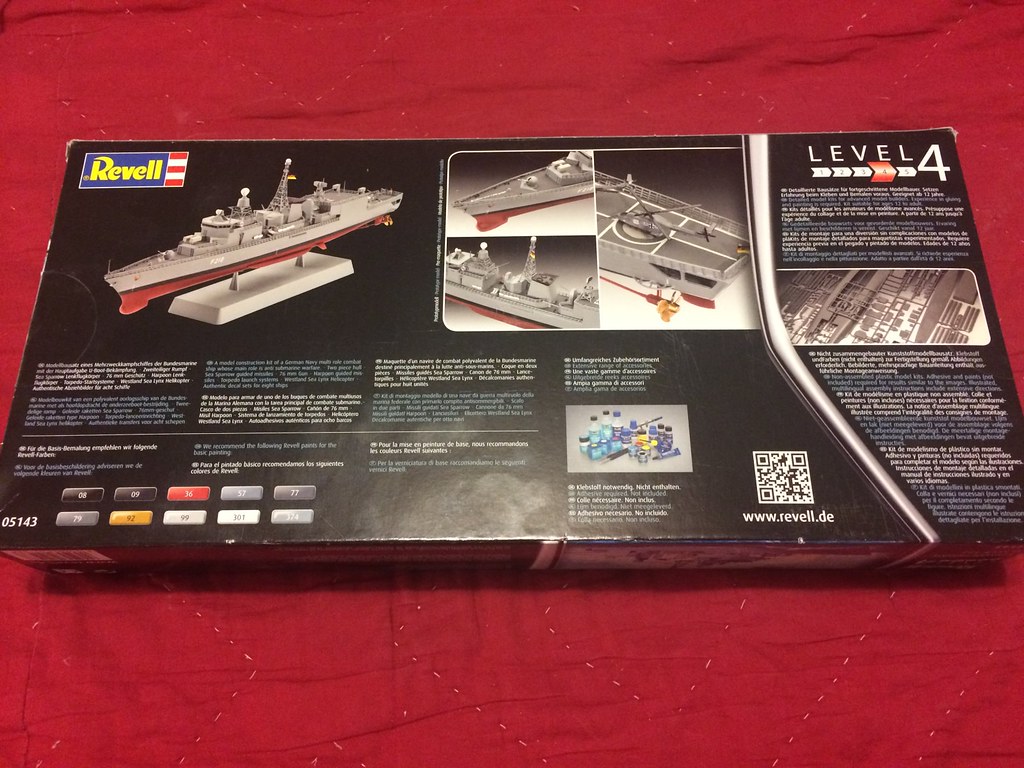
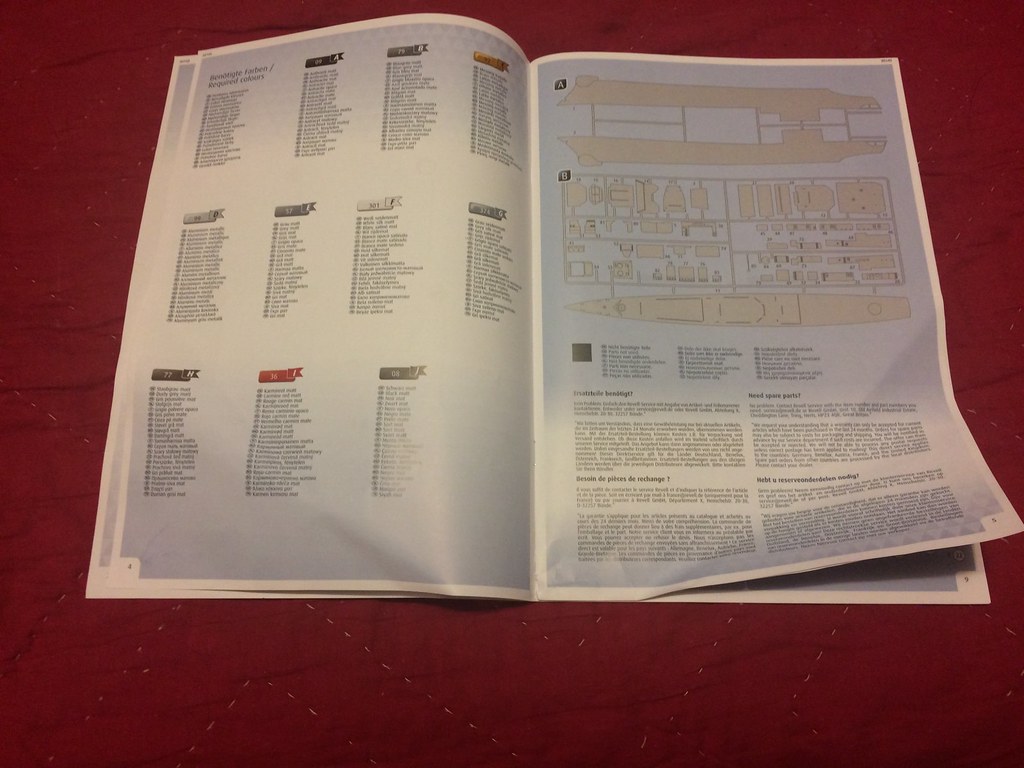
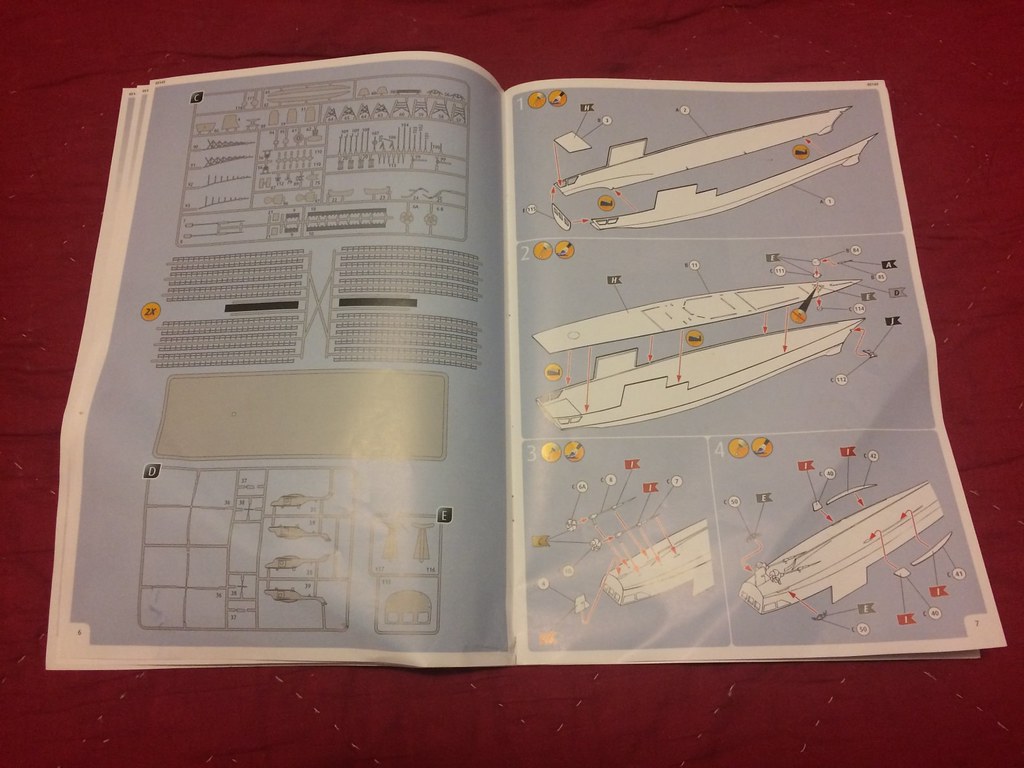
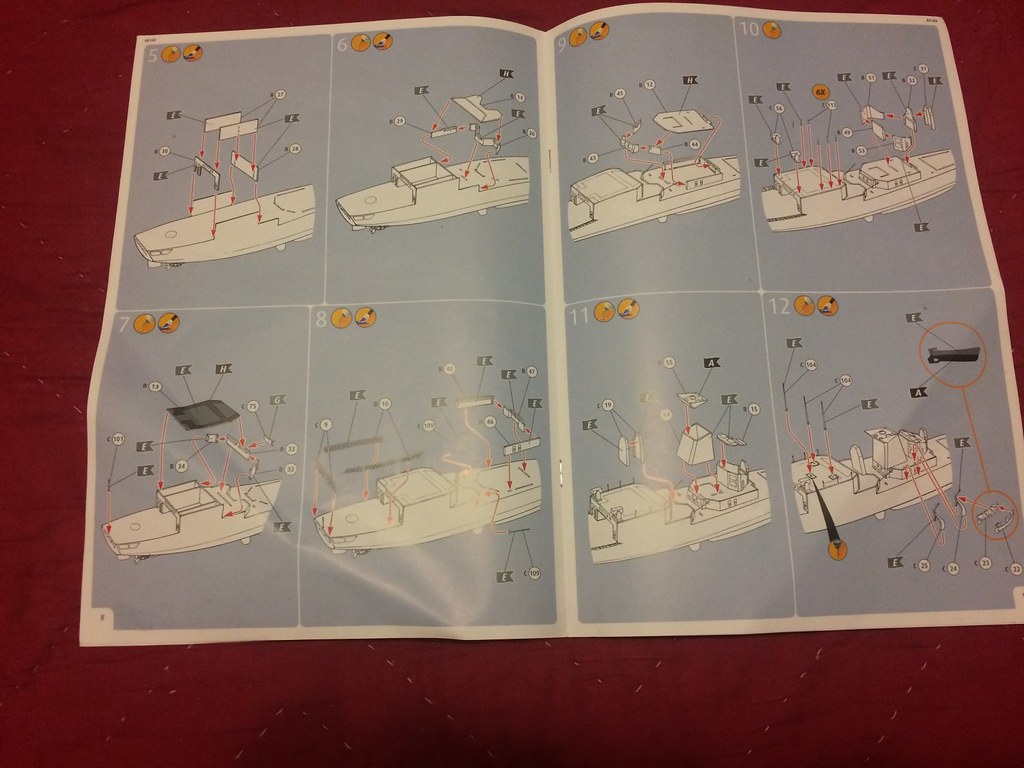
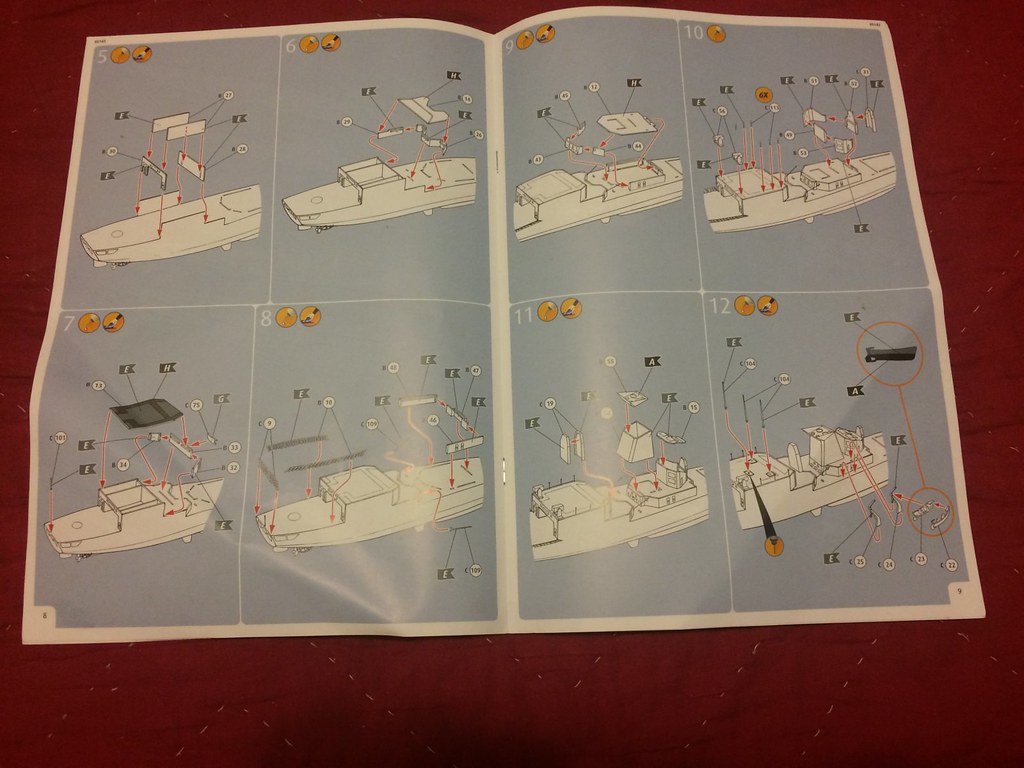
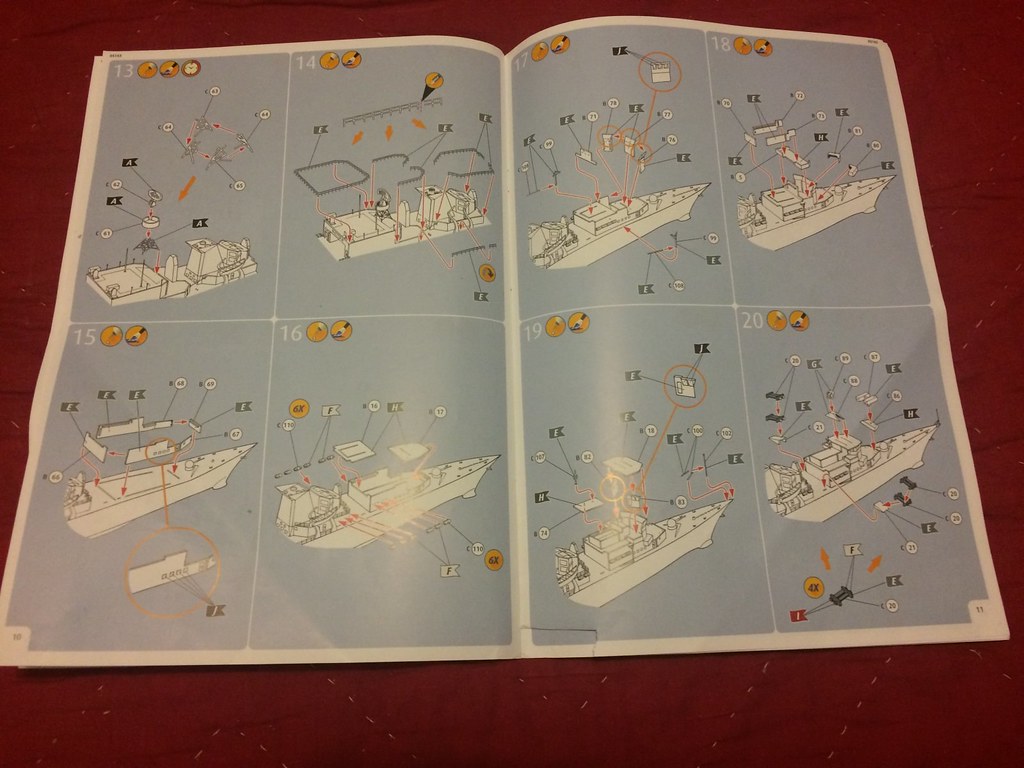
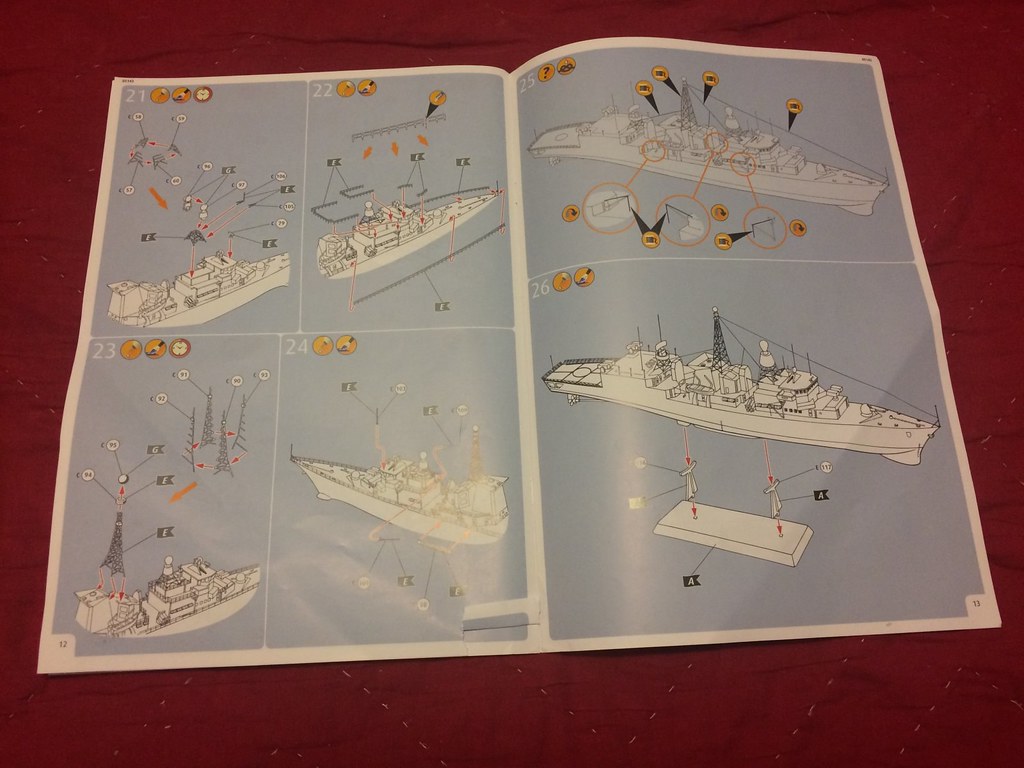
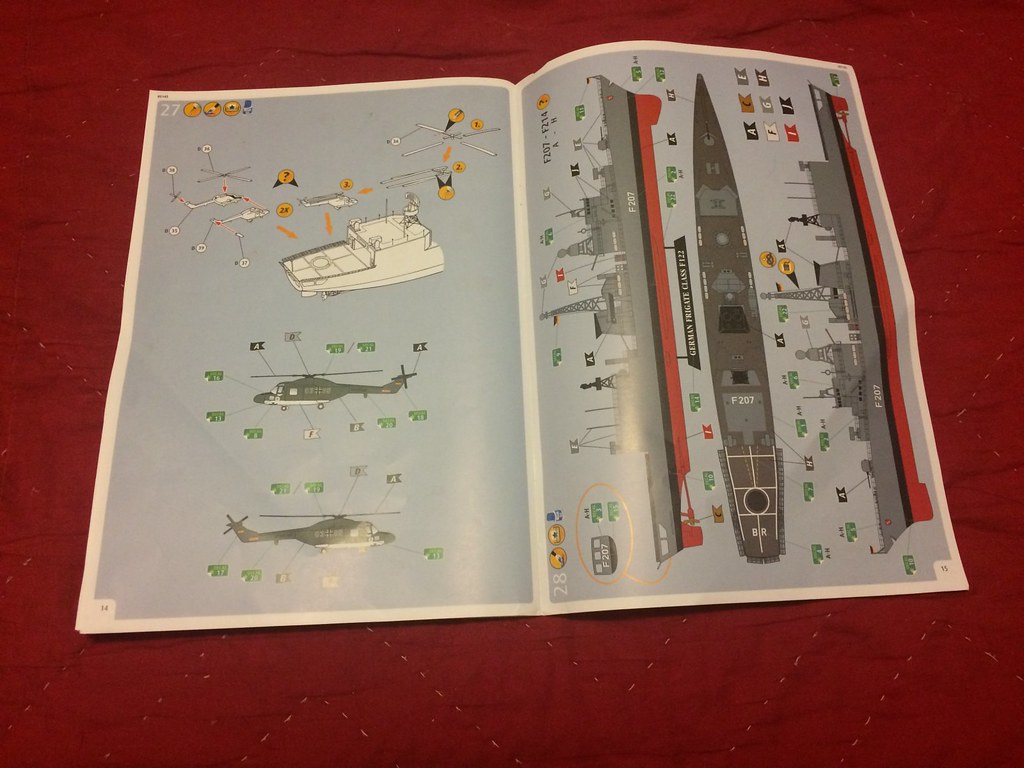
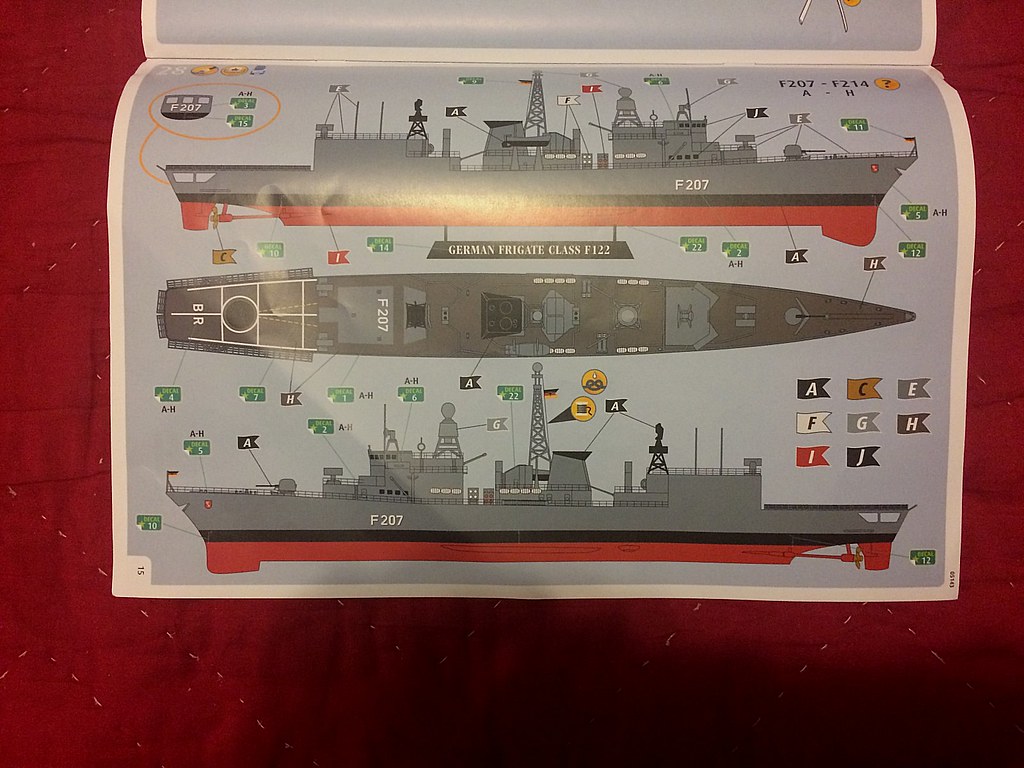 The Build - Hull, props and rudder, hangar, painting the hull - February 19, 2017
The Build - Hull, props and rudder, hangar, painting the hull - February 19, 2017
I started the model by building the hull, and then adding the props and rudder:
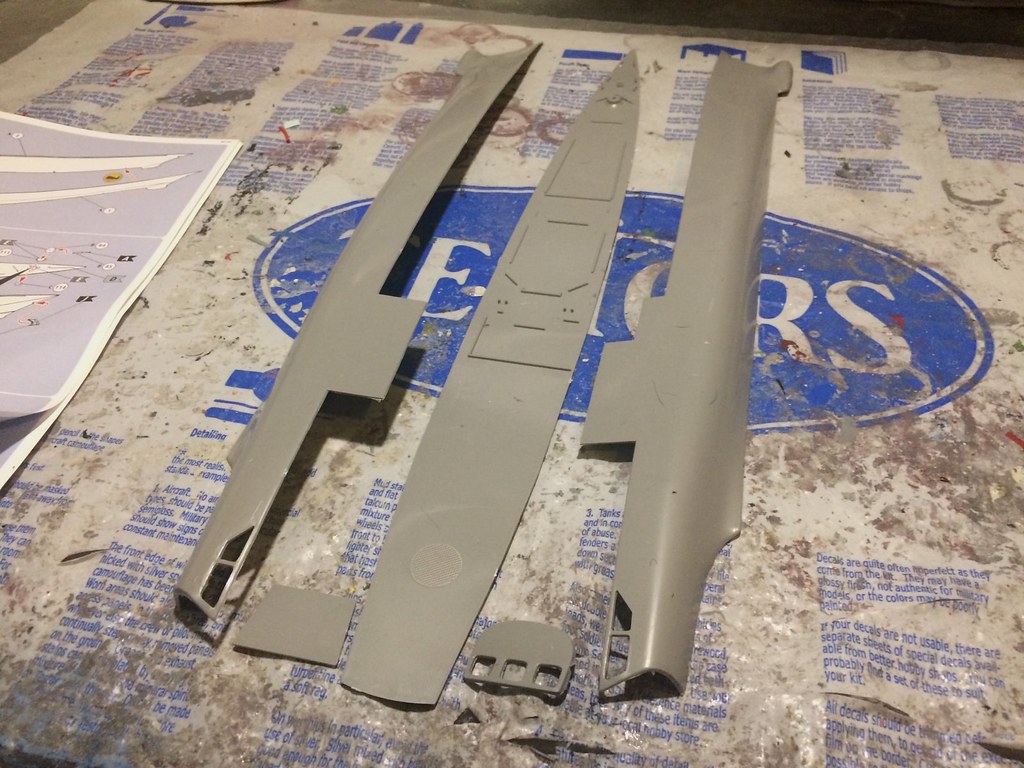
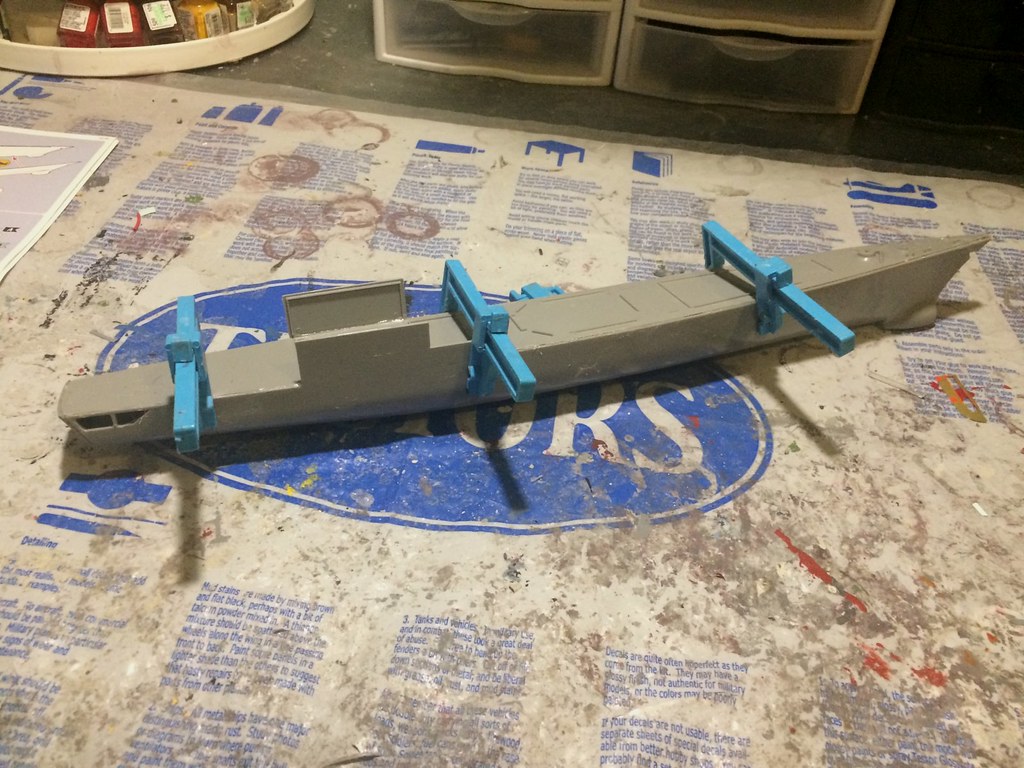
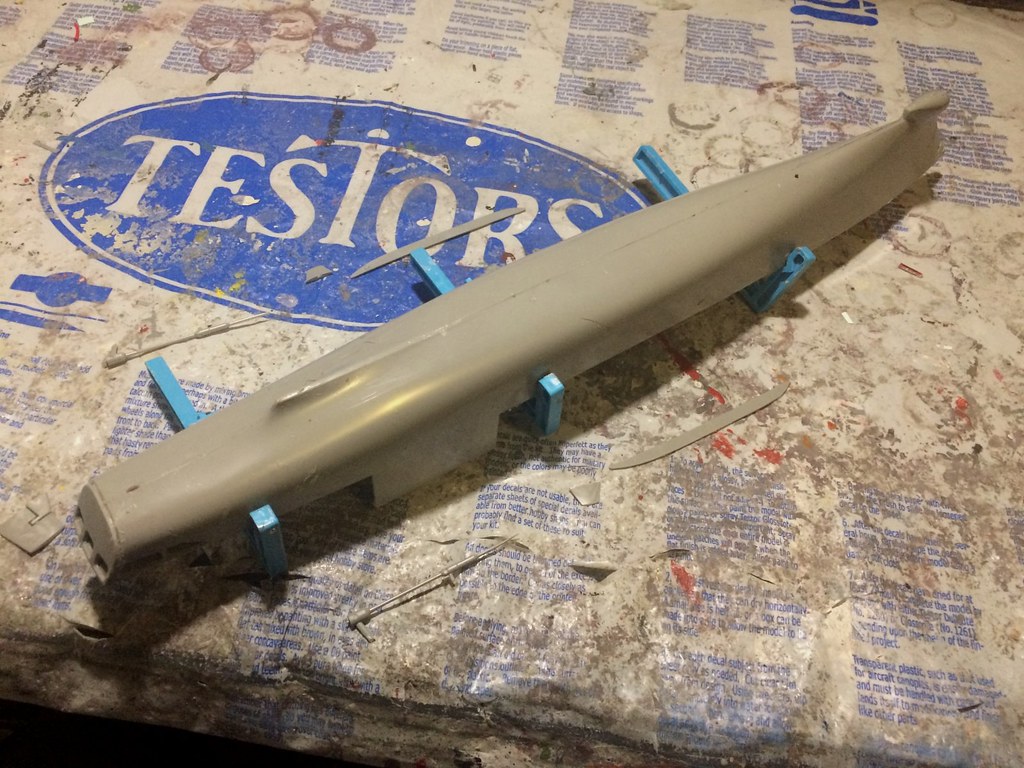
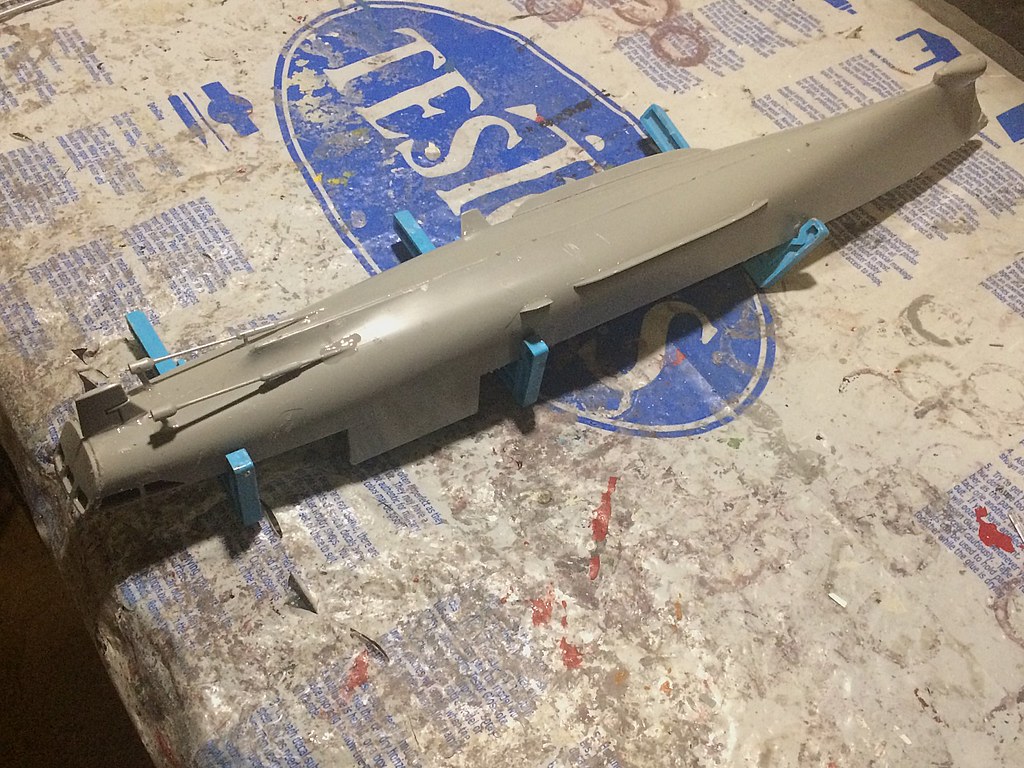
I then added the hangar to the after portion of the ship, and then painted the lower hull red and the waterline mark black:
Here's how that went:
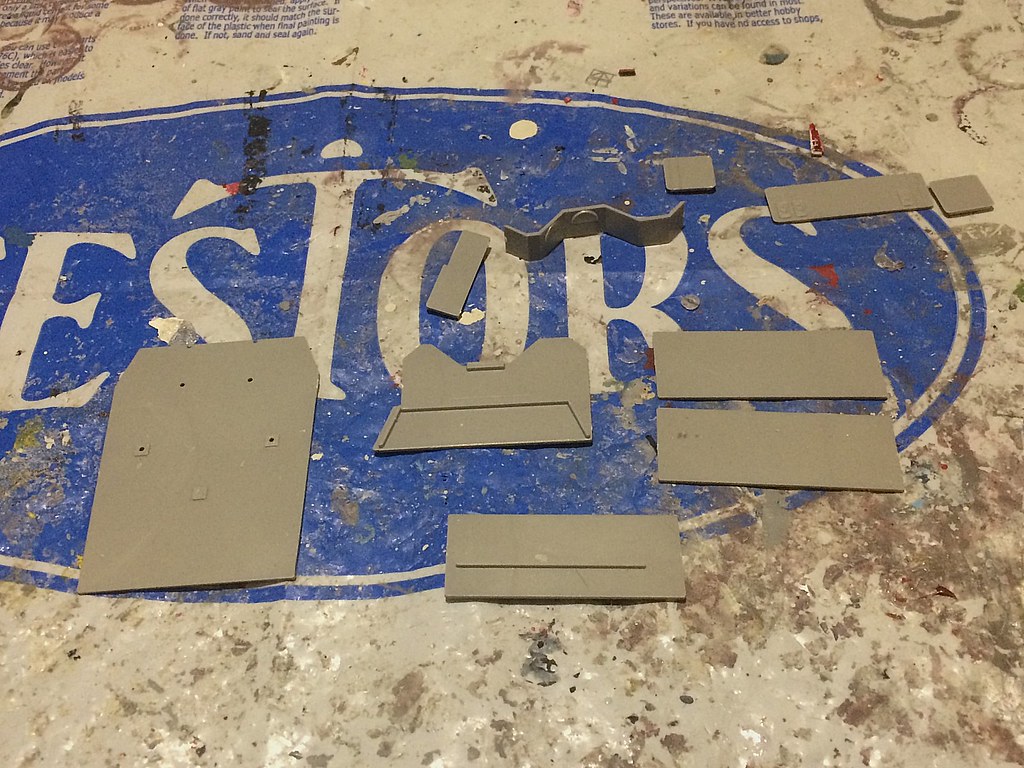
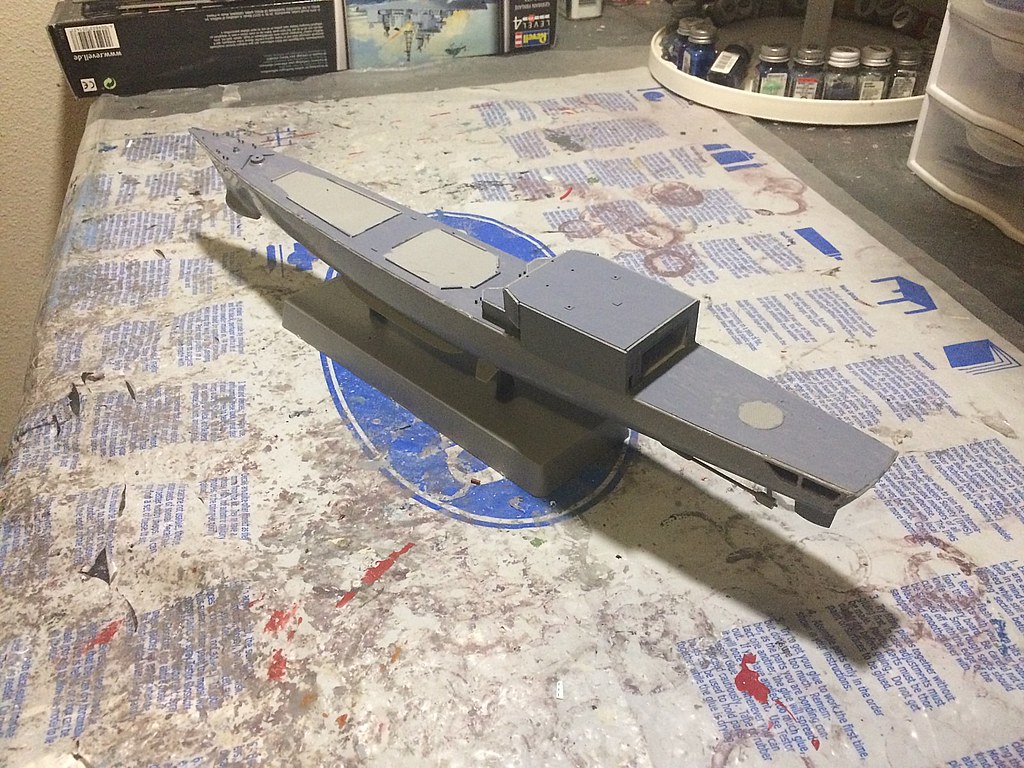
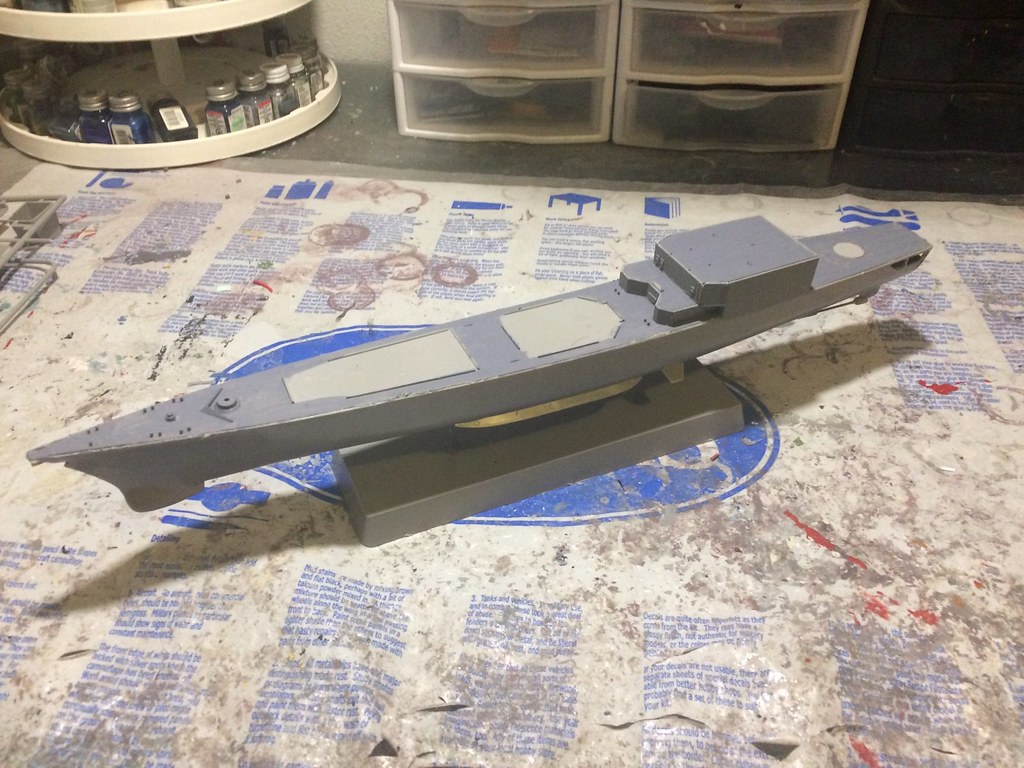
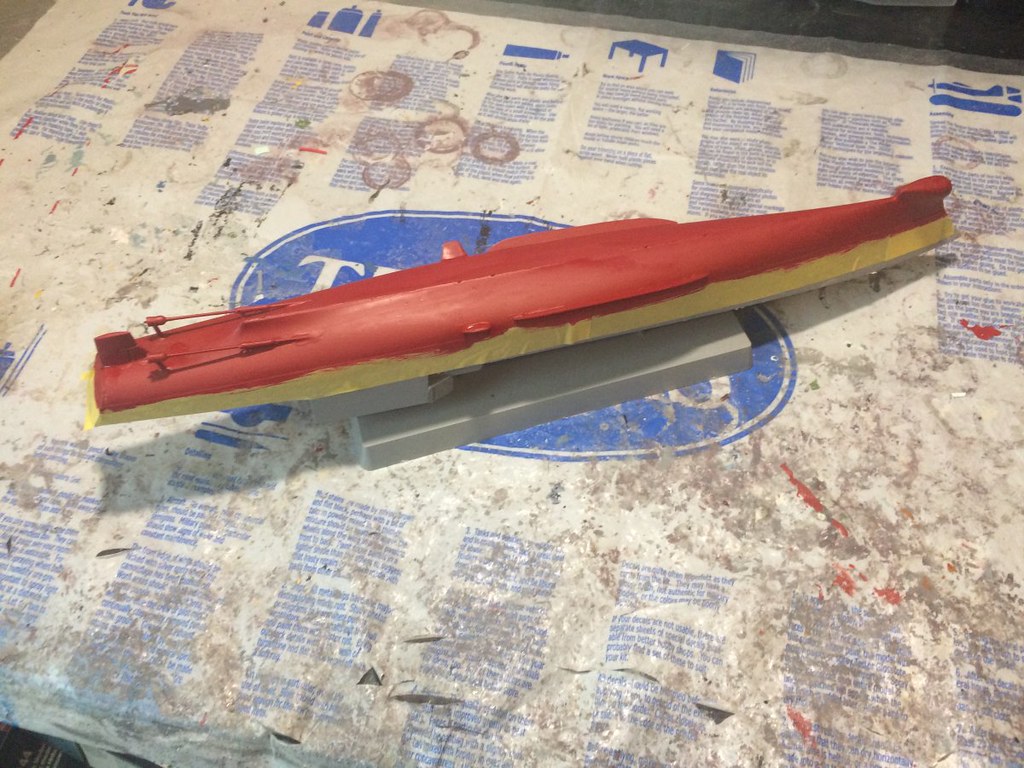
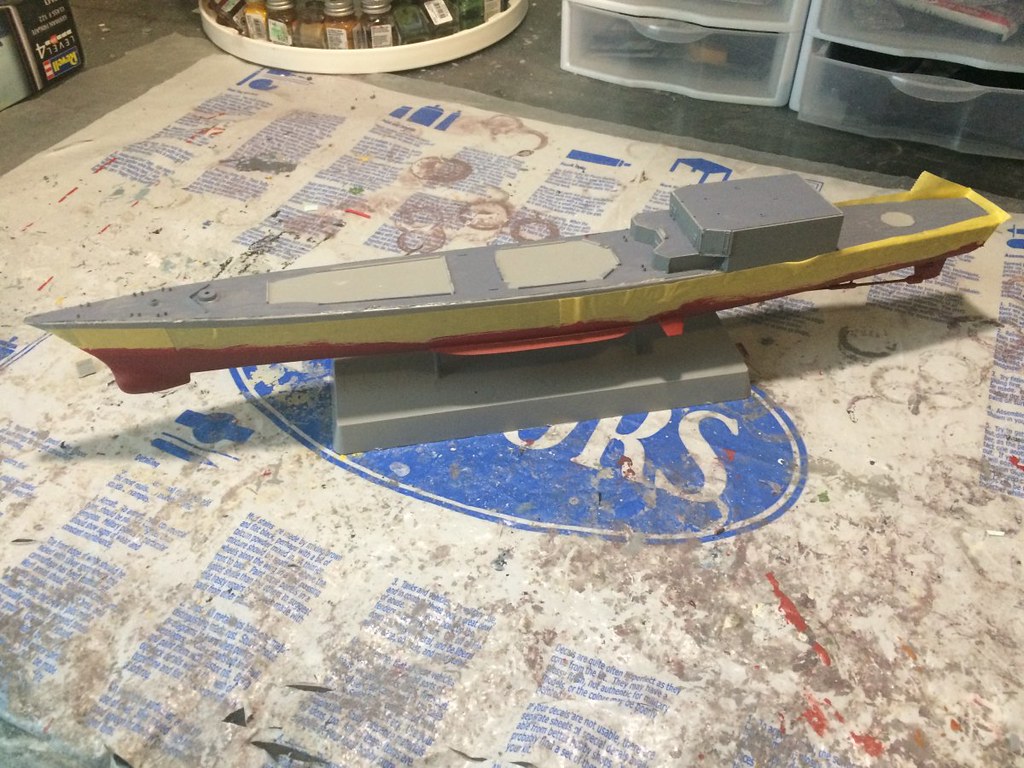
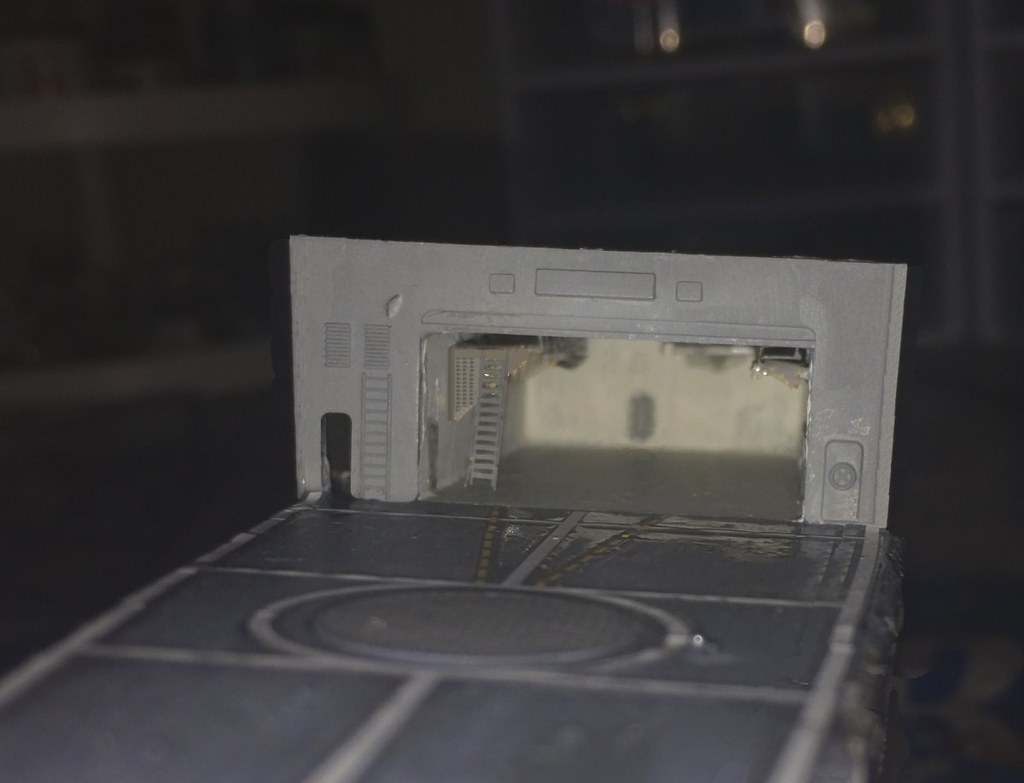
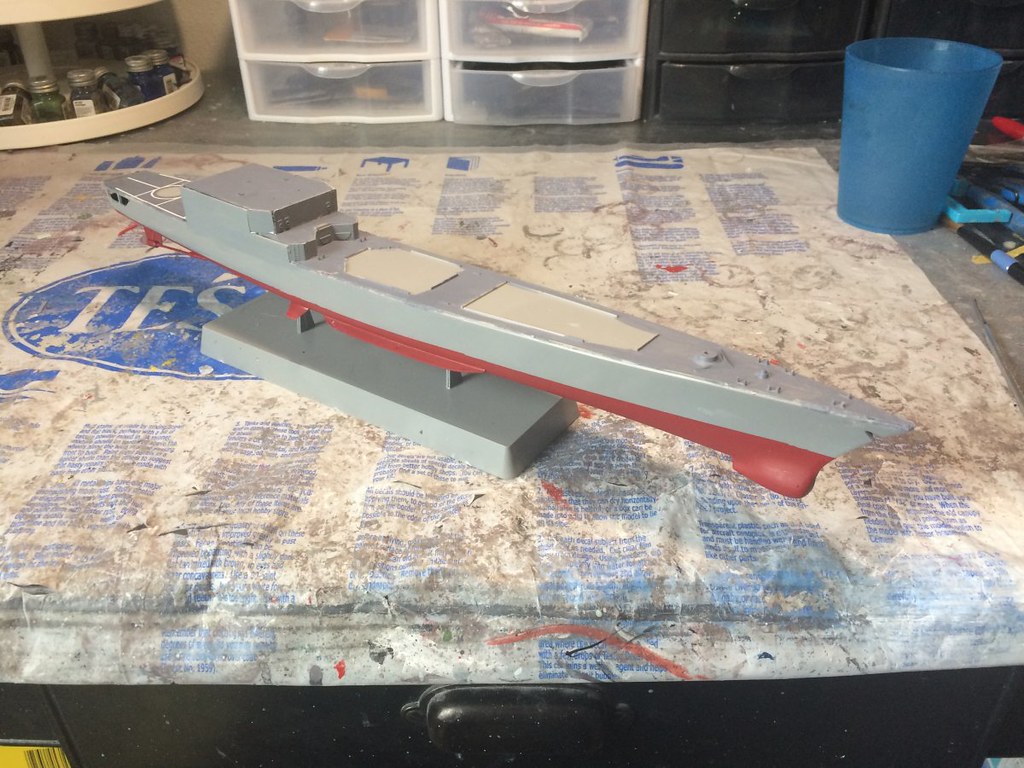
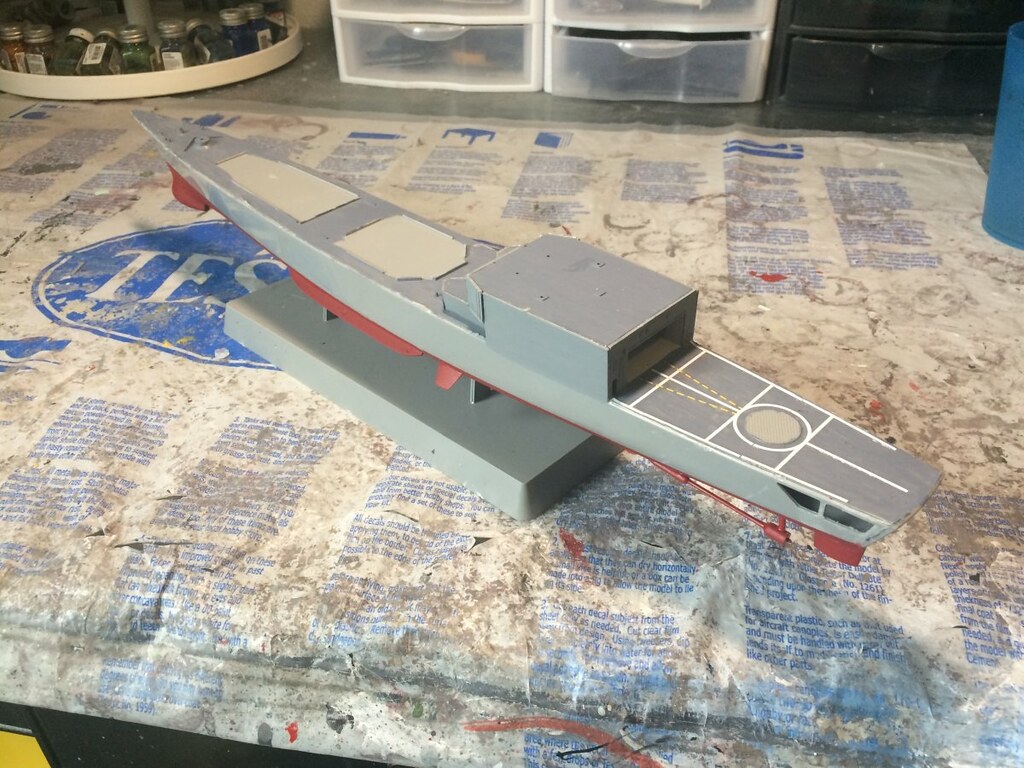
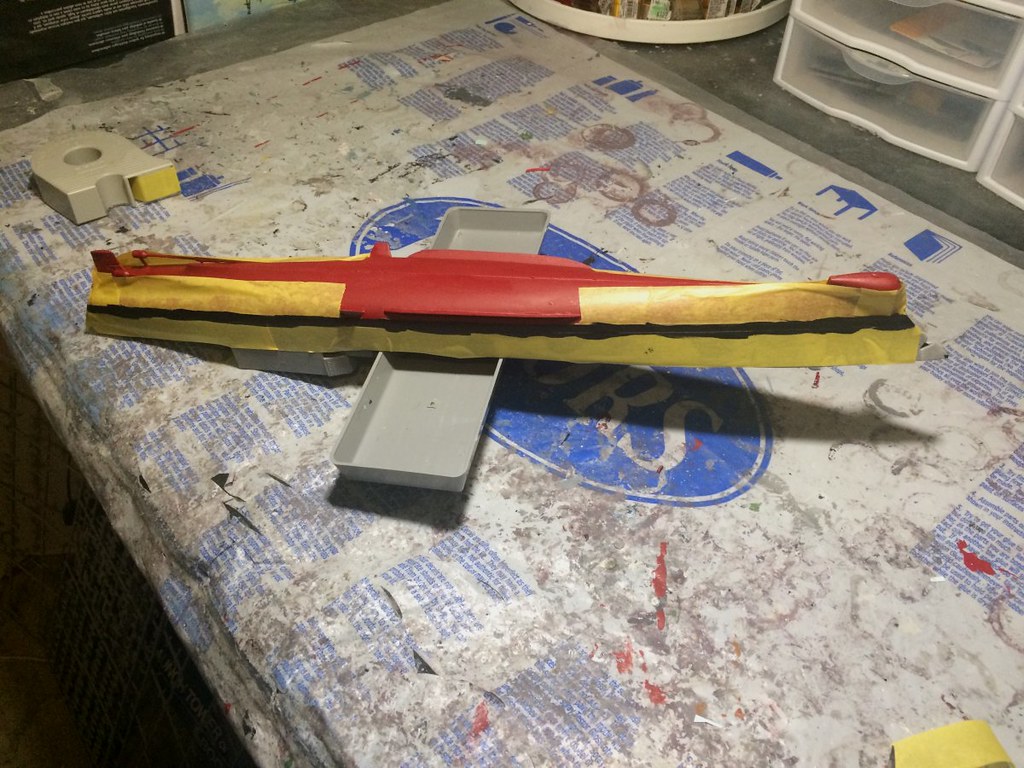
Looking good.
In the next session I will begin adding the smoke stack and its deck house, the bridge, the masts and the weapons systems. ....pictures so far. I will add the descriptions later:
The Build - Adding the two main deck houses, the main weapons, and the helicopters - February 20, 2017
At this point it was time to build the two main deck houses.
Aft is the smoke stack and its deck hose and forward of that the main deck house including the bridge, , you have the bridge and first smoke stack combined into on. This holds the forward CIWS, the bridge and AEGIS Phased Array Radars (PARs), and ultimtely the main mast and then the smoke stack behind that.
Here's how they look once built and attached to the vessel. I added the decals for the landing pad at this time too:
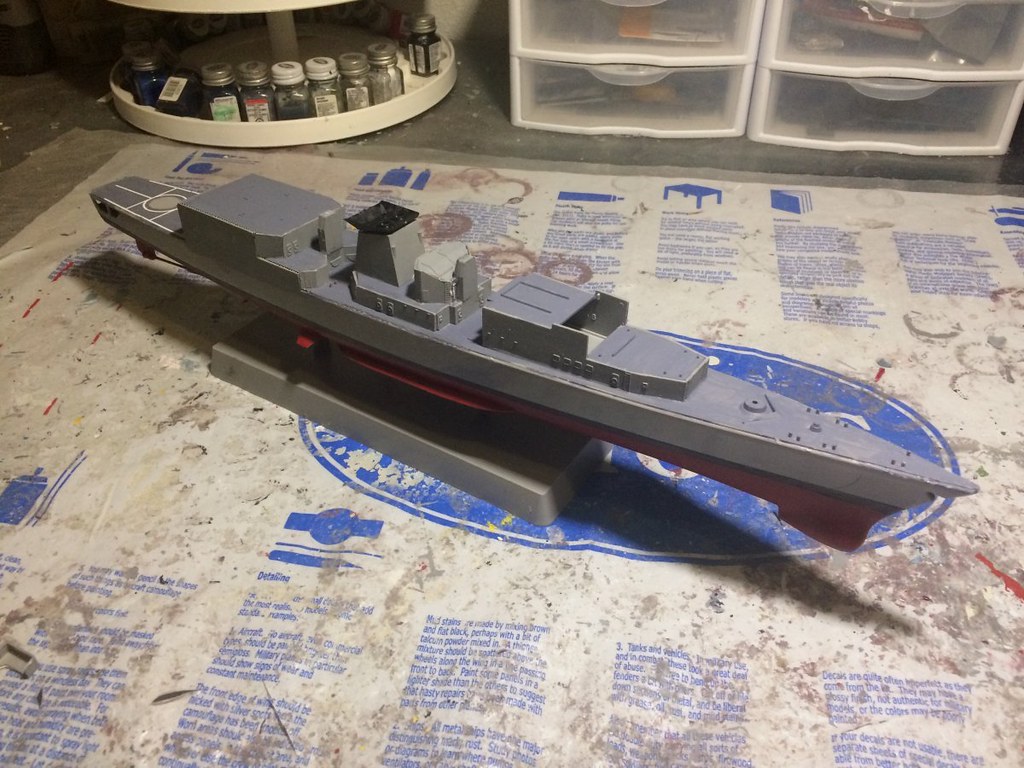
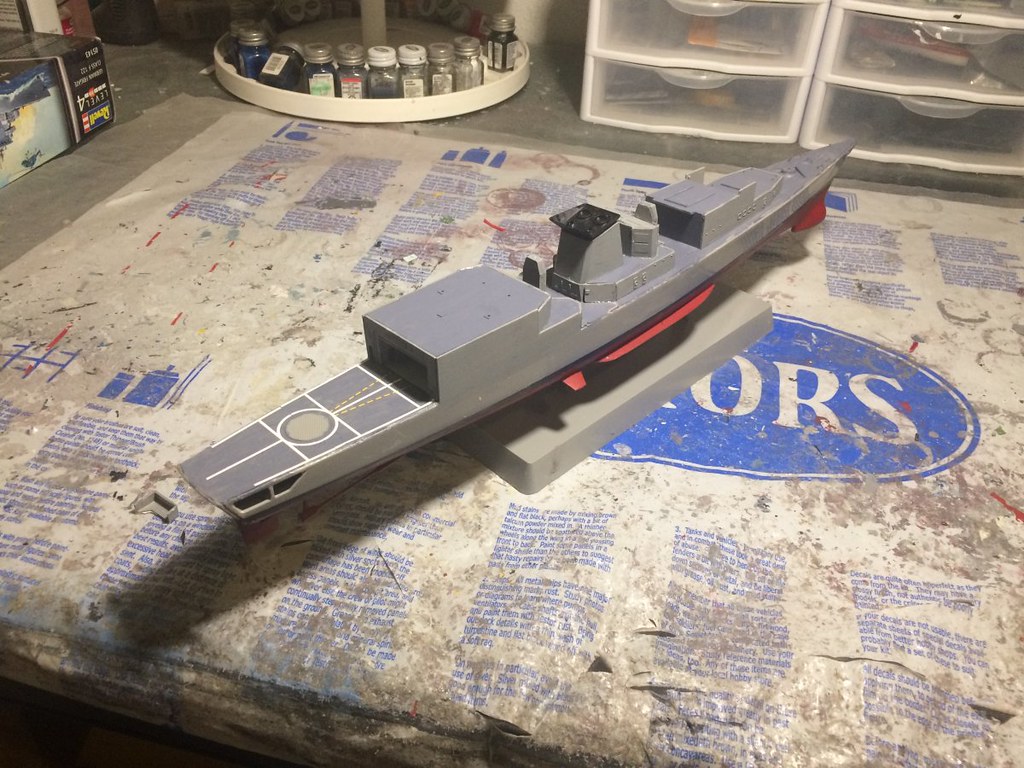
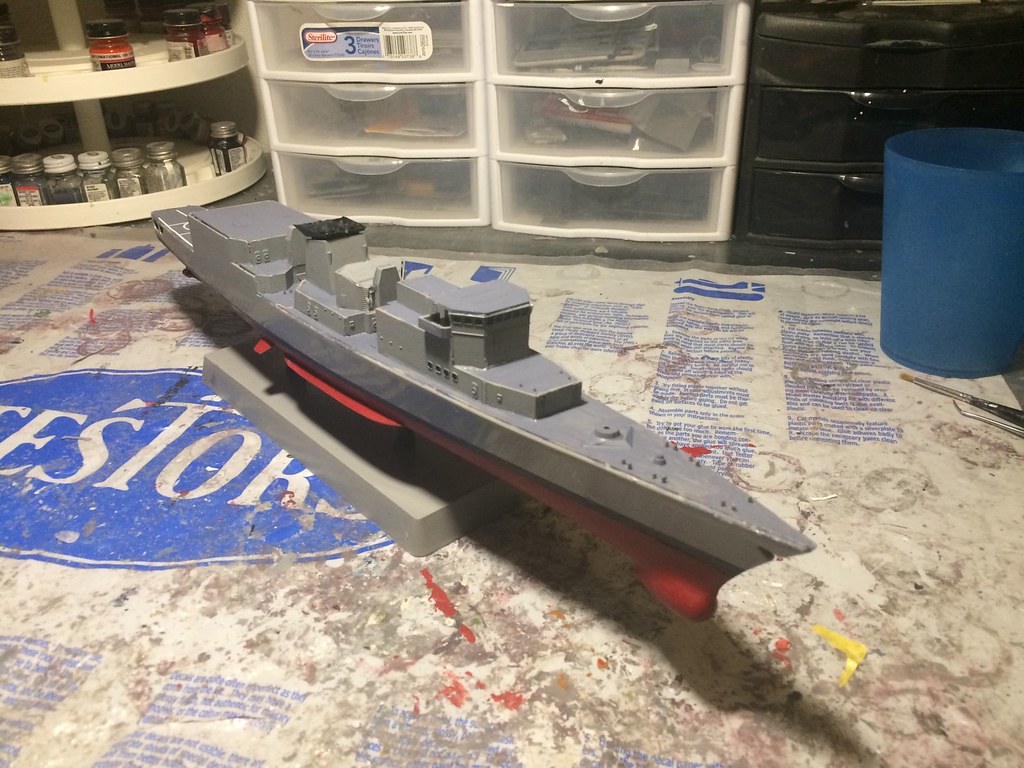
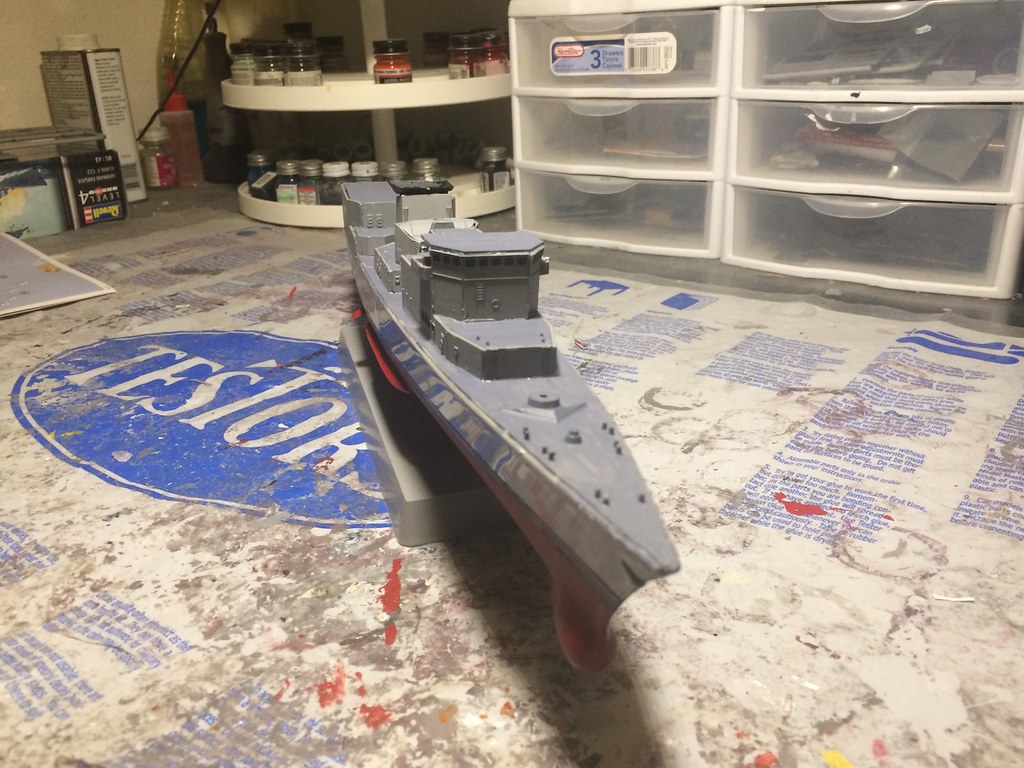
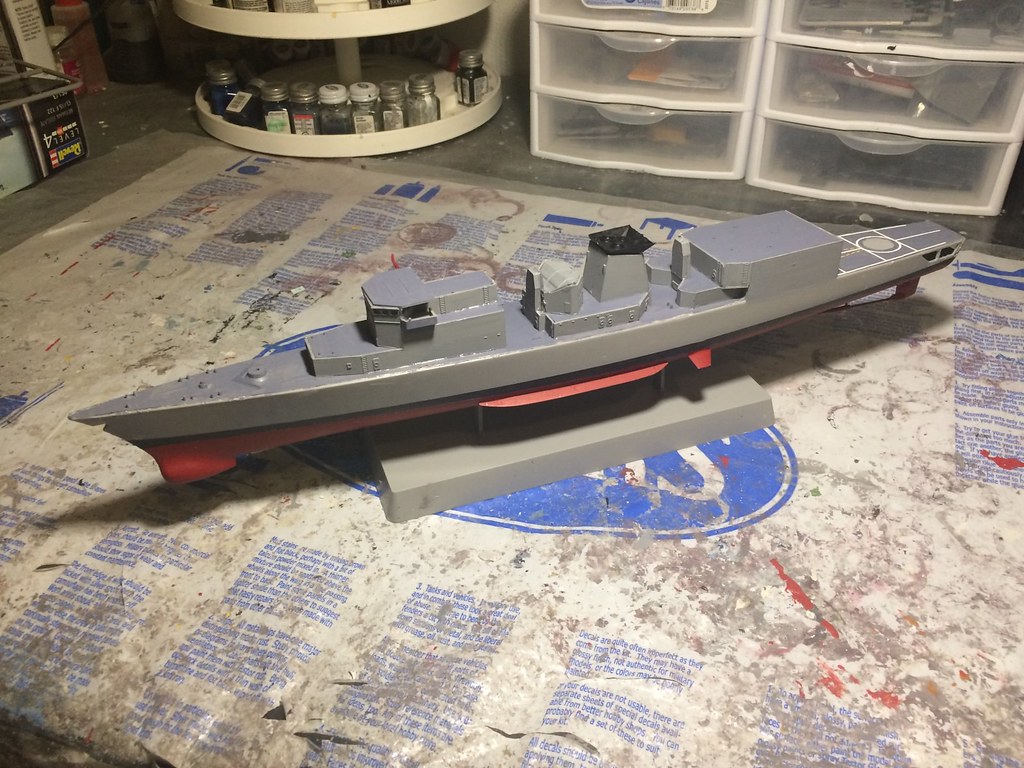
At this point I added the masts and sensors, and then the main weapons. This included the 76mm inch gun forward, the Mk-29 Evolved Sea sparrow launcher forward, the quadruple Harpoon launchers amid ships, and the RAM launchers on top of the aft portion of the helicopter hangar.
Here's how that looked:
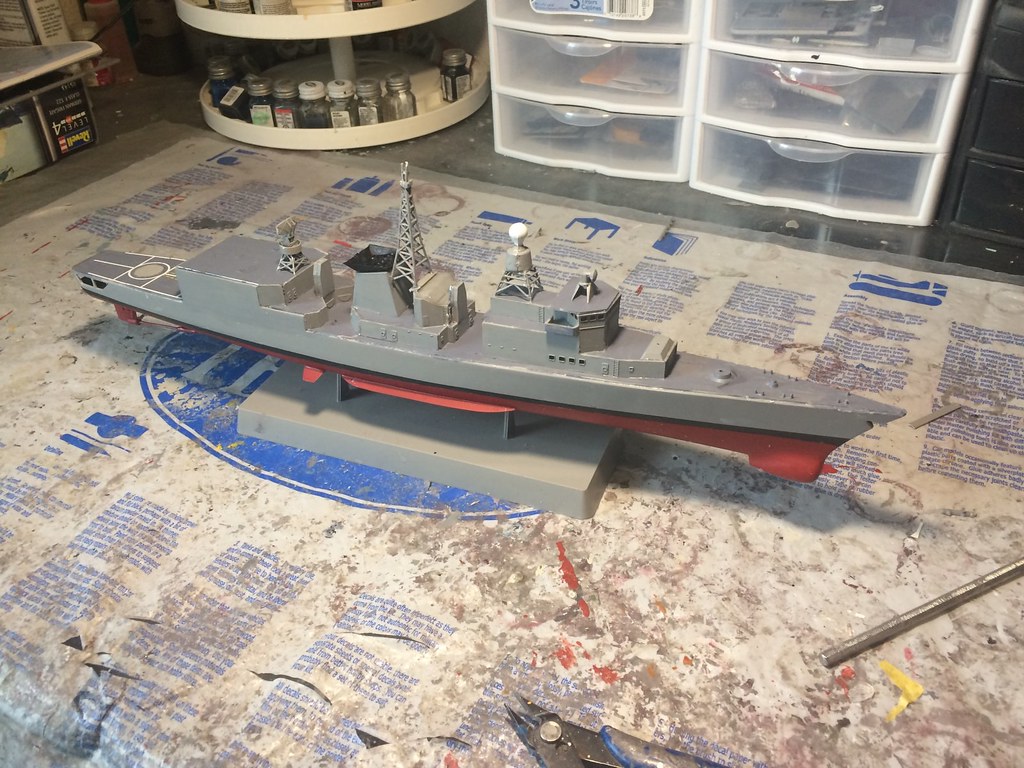
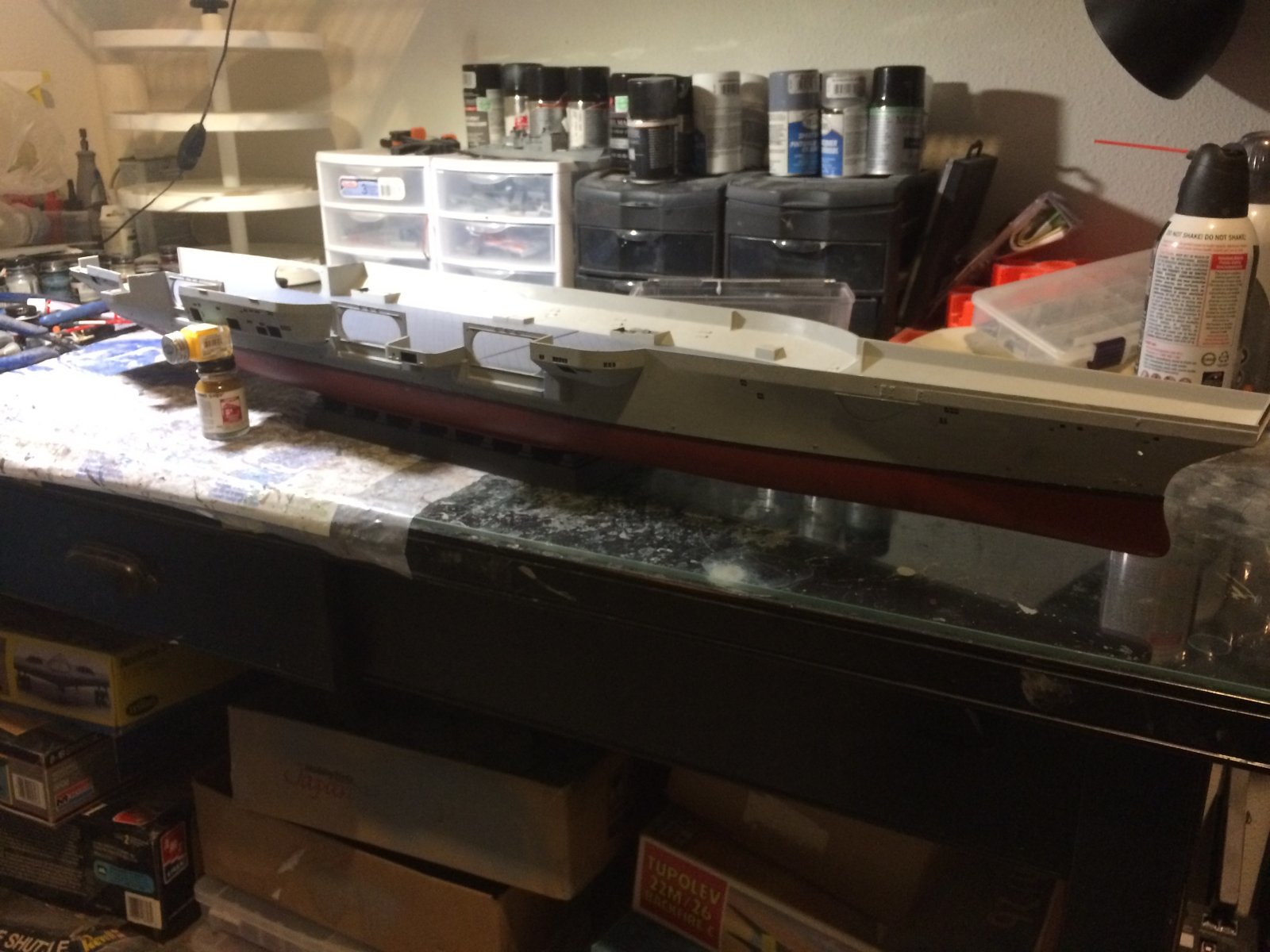
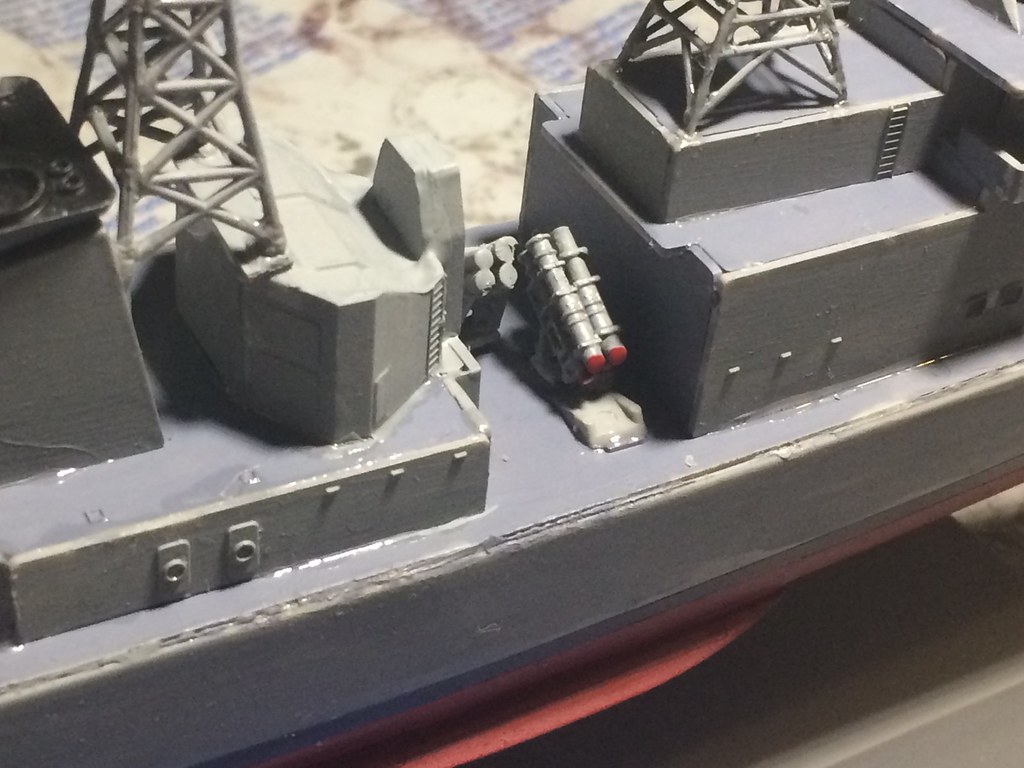
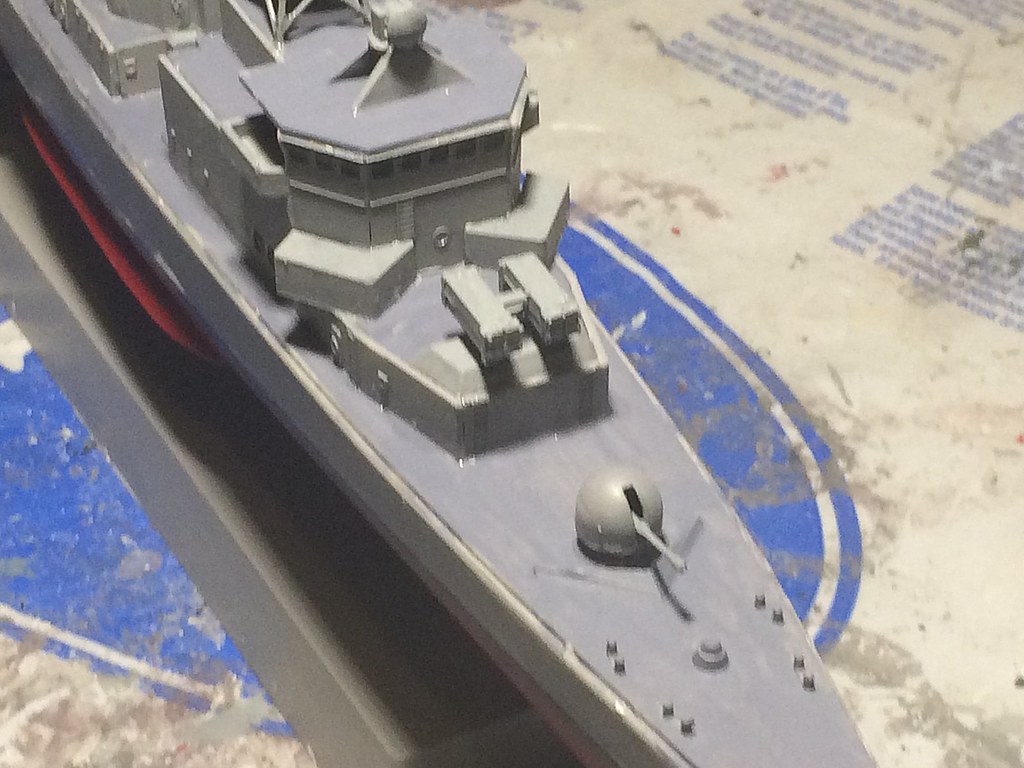
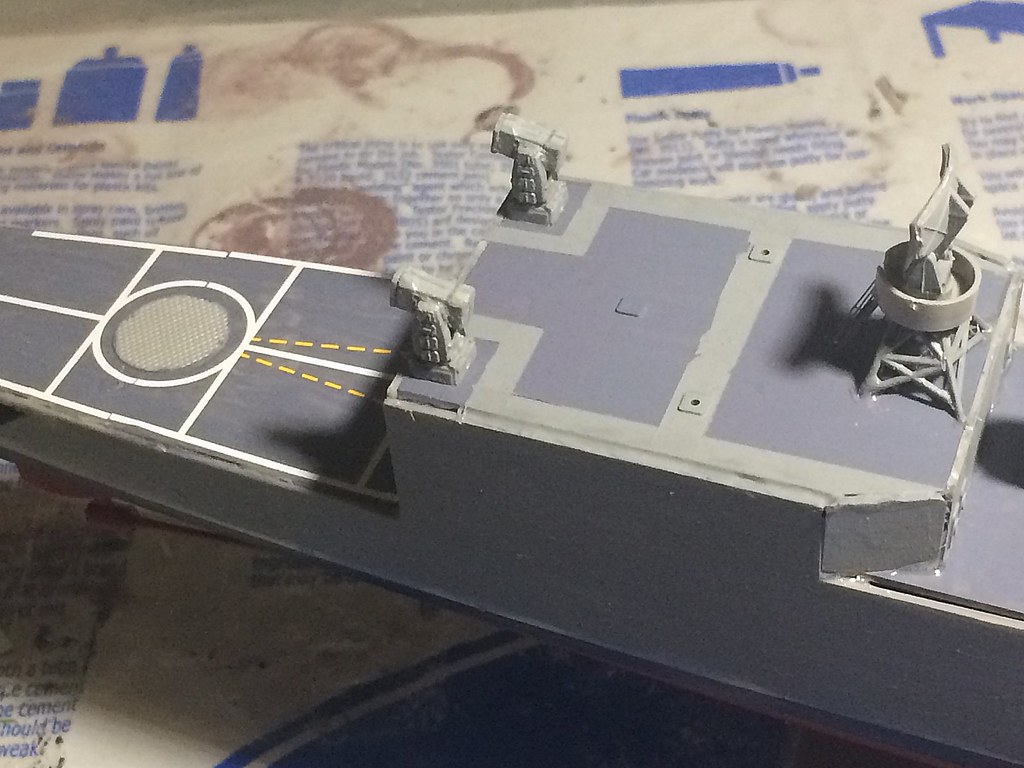
I then built, painted, added the decal to, and then placed the Lynx helicopters on the vessel. I had done some detail work on the enterior of the hanger deck...it cam just plain and we needed some auxillary decks fro maintenance and the railing and water tight doors to access them and the main level of the hanger.
It turned out pretty nicely:
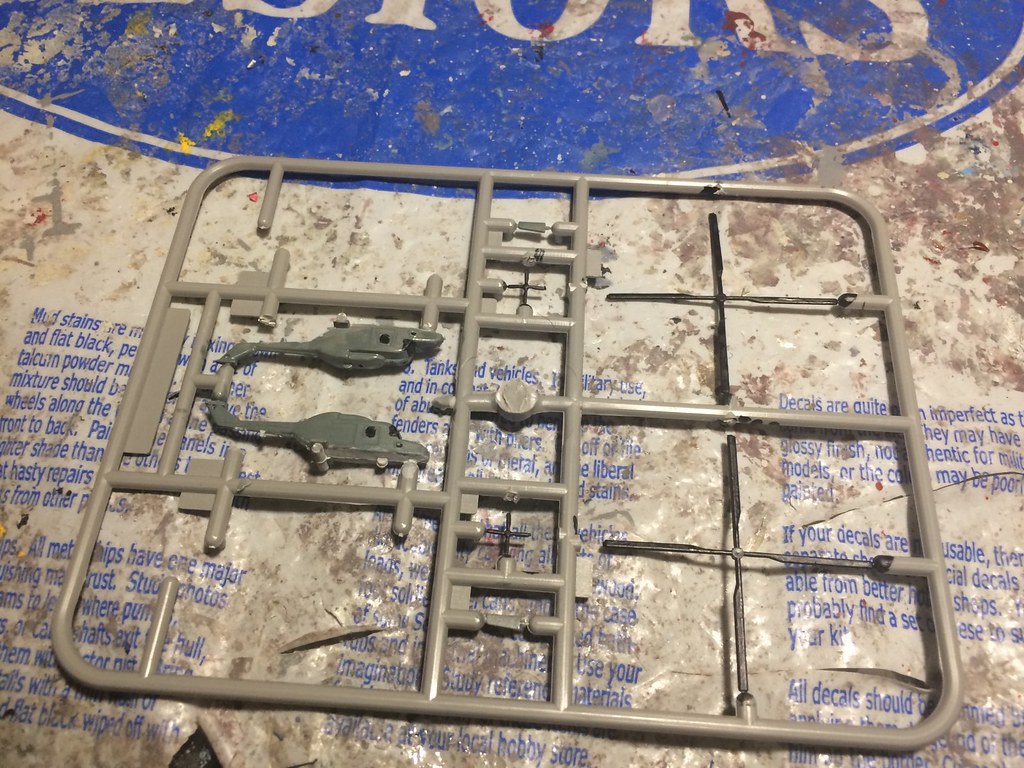
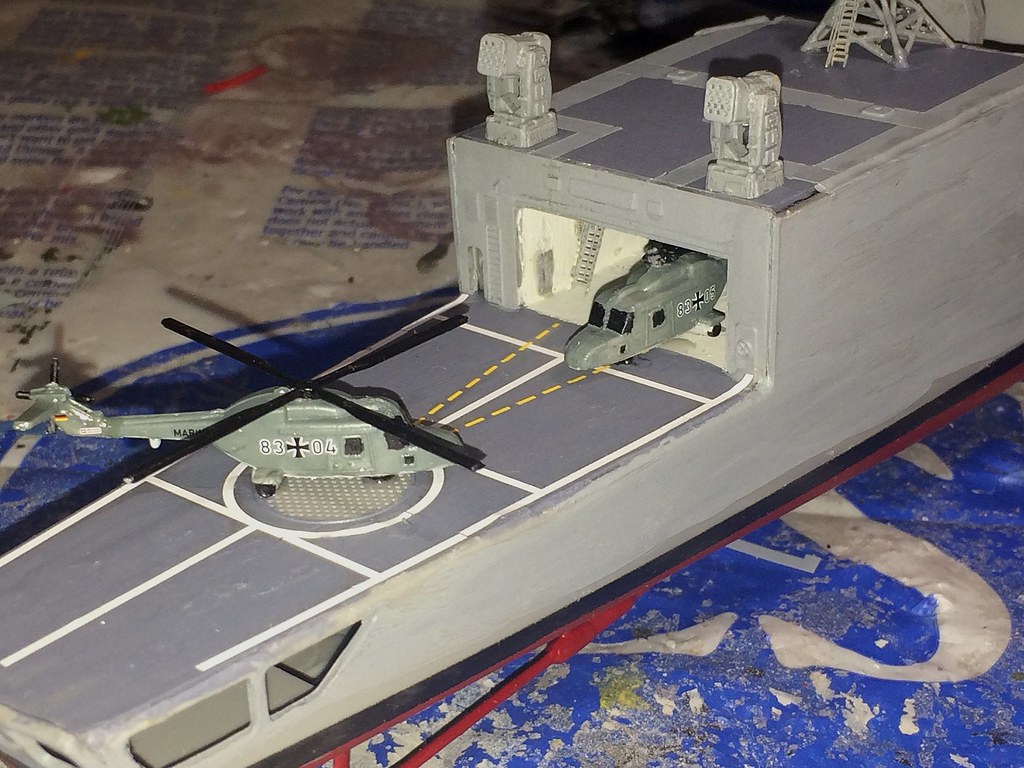
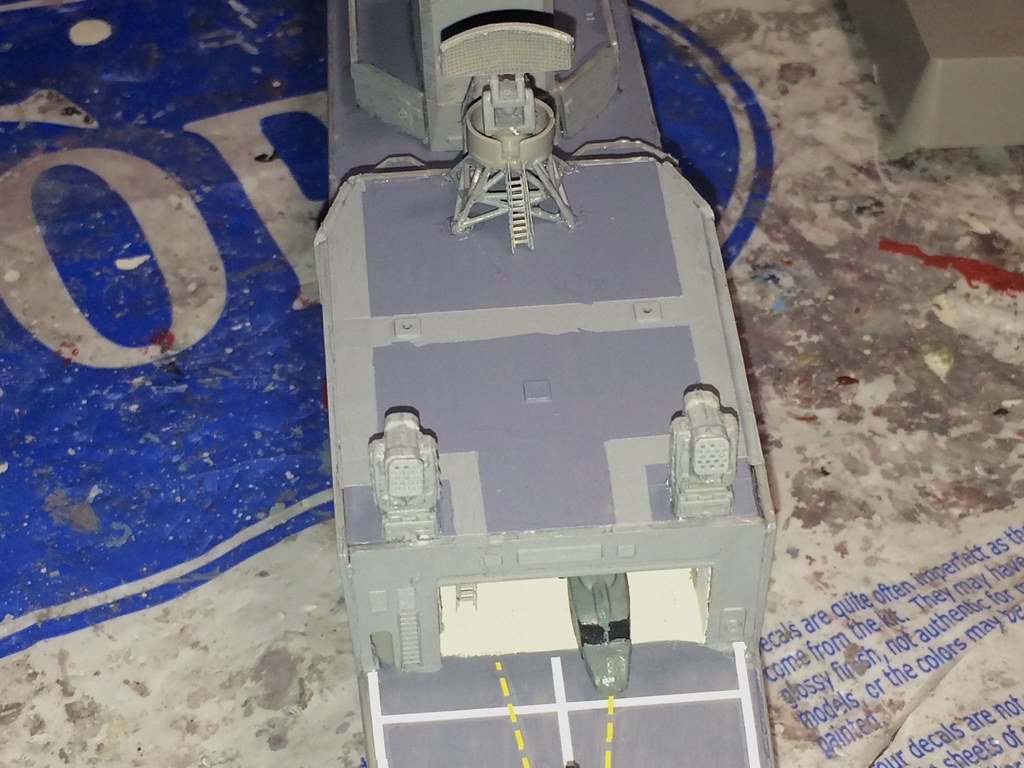
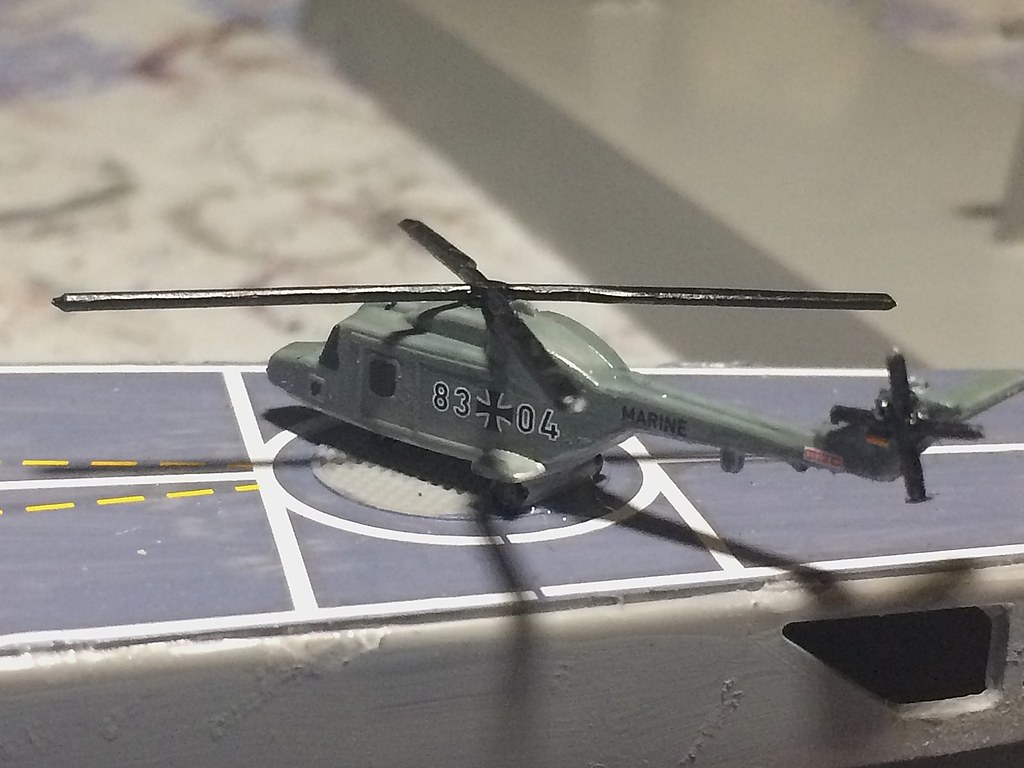
That is looking very good now. In the next session I will ad a lot of details to the entire vessel, along with the railings, ladders/stairs, and other equipment photo etch equipment...and also add the decals, do the touch up, and complete the model.
The Build - , Details, Photo Etch, decals, touch up and complete - February 21, 2017
In this session I added a number of details, added the photo etch metal parts and then the decals.
Quite a bit of work...but I had the entire day to work on it and it turned out nicels.
Here's how that went...and these photo etch railings look far superior to the plastic, very thick and bulky railings that came with the model.
Lots of stuff and pictures from this session:
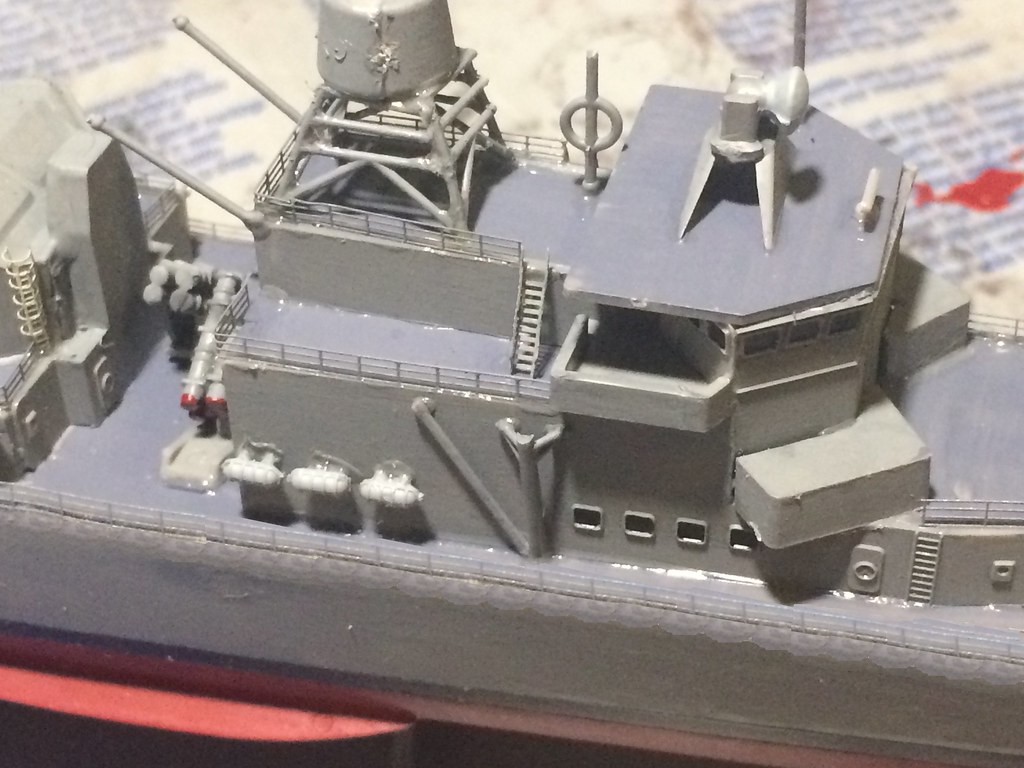
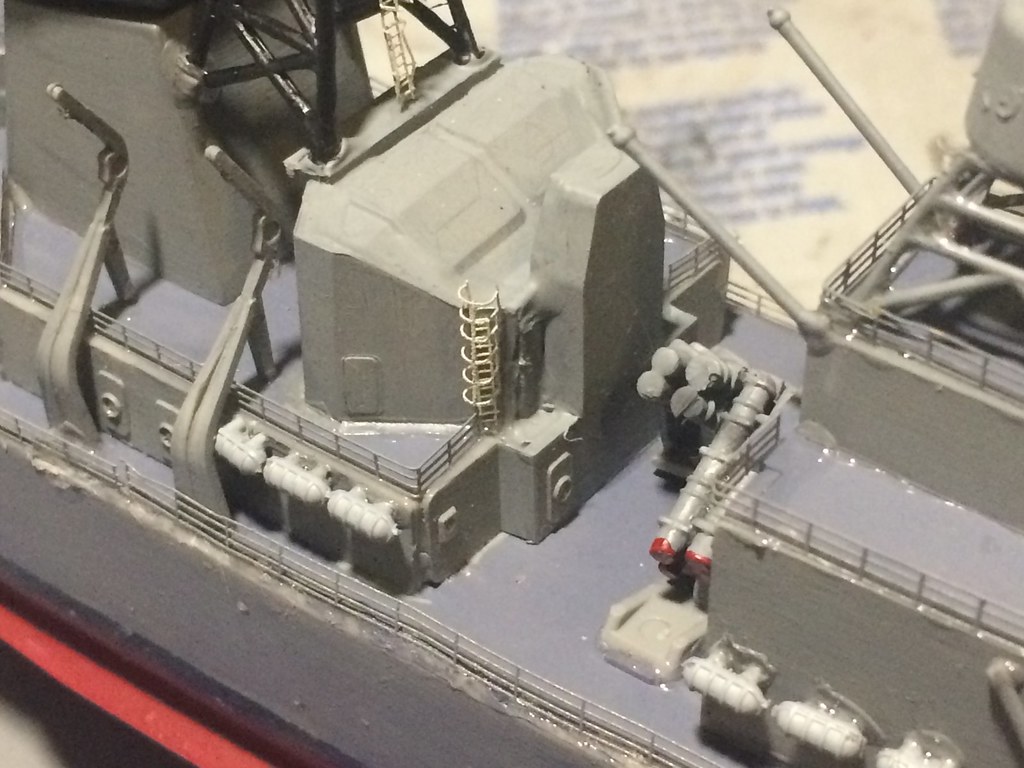
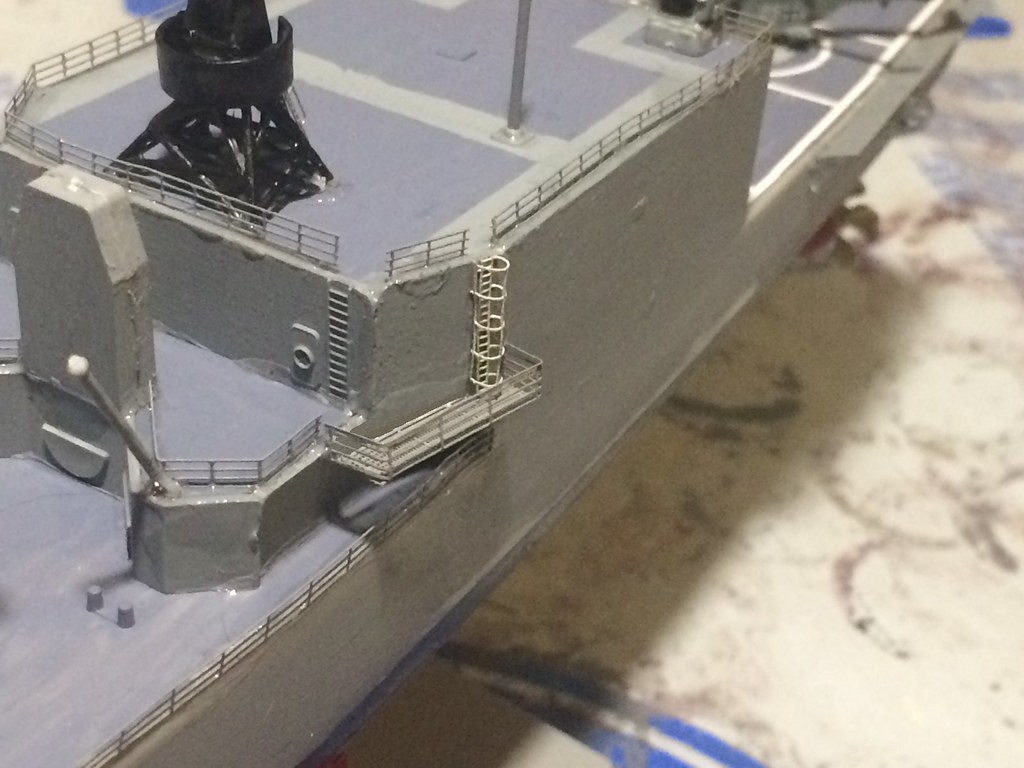
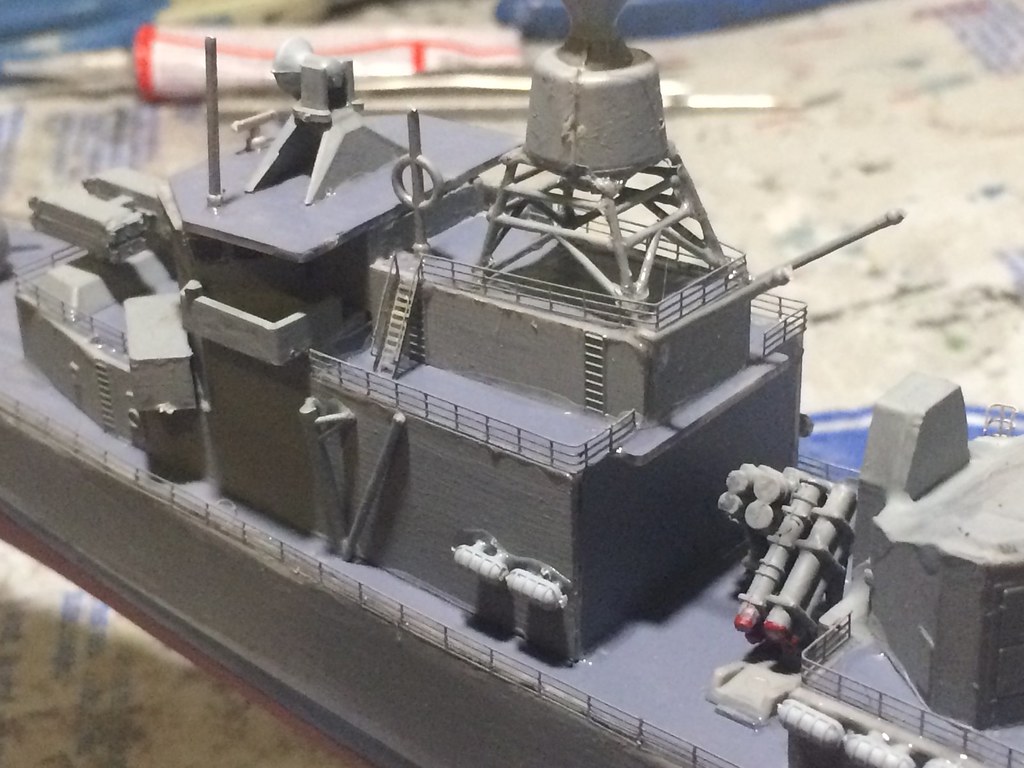
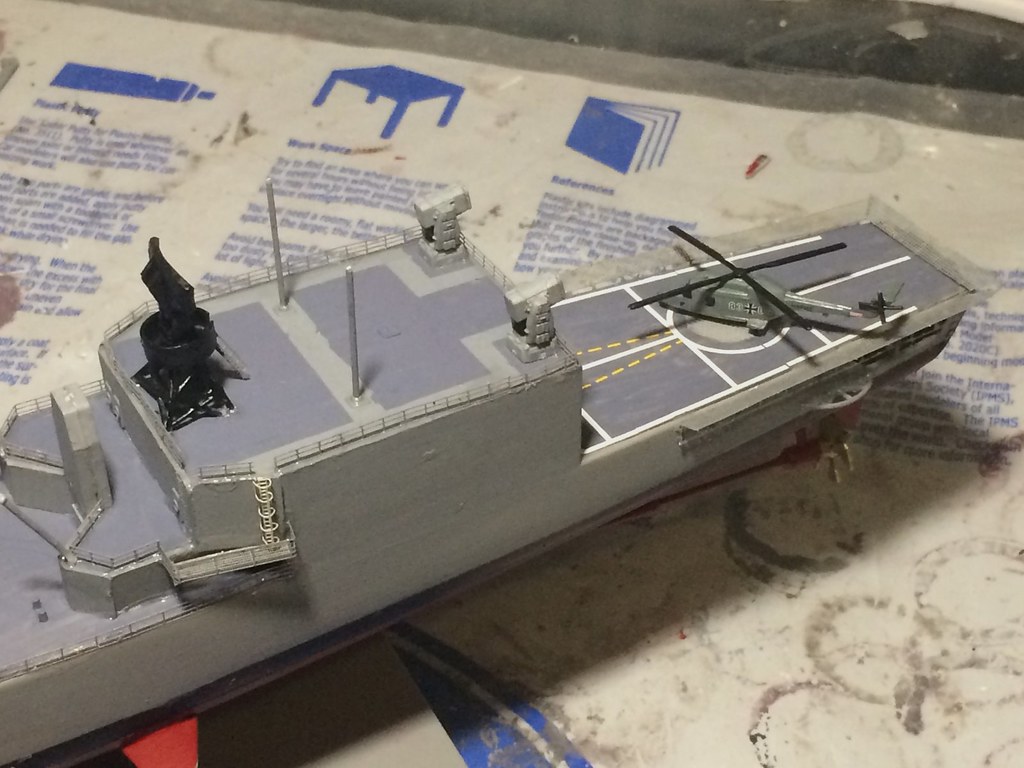
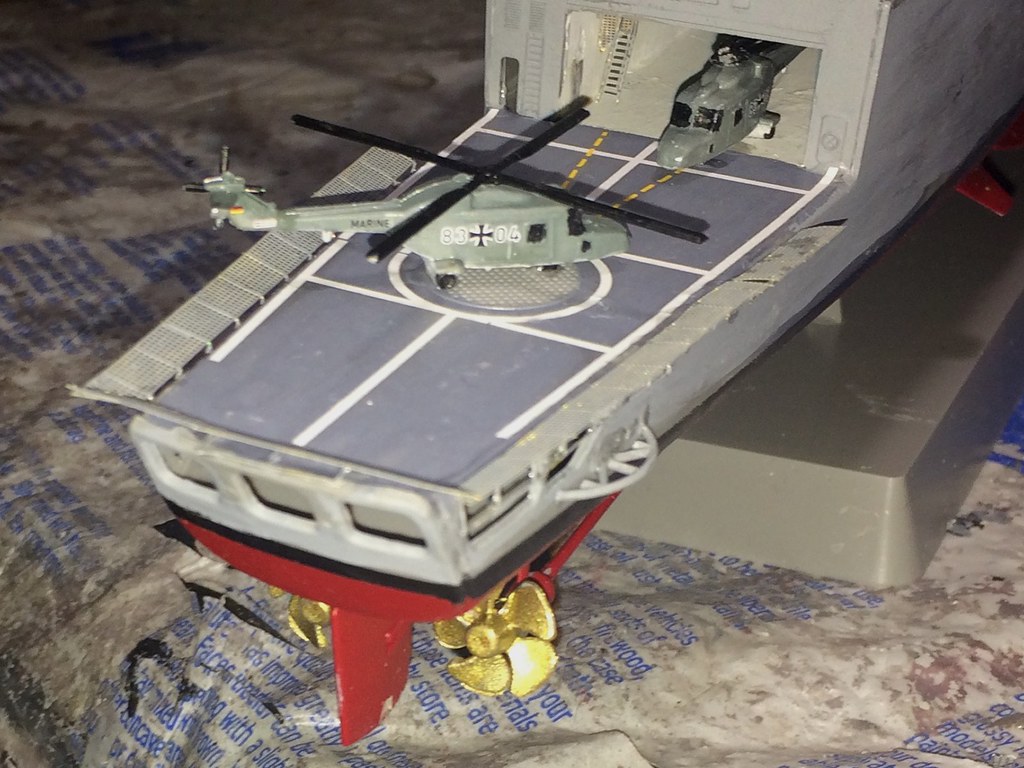
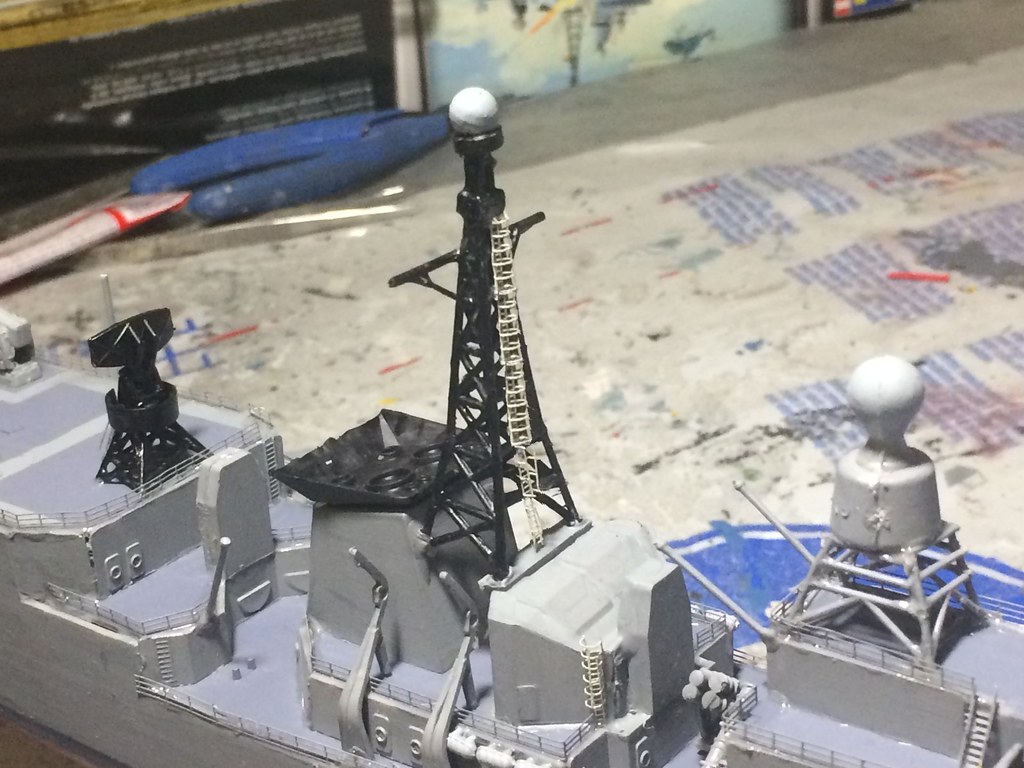
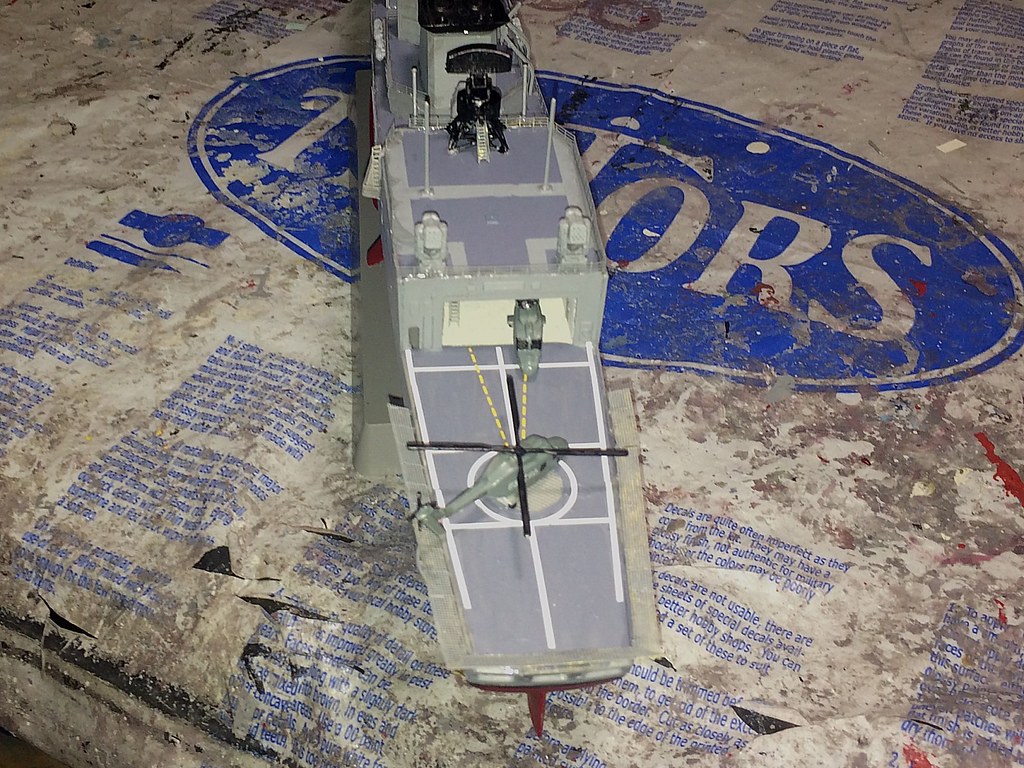
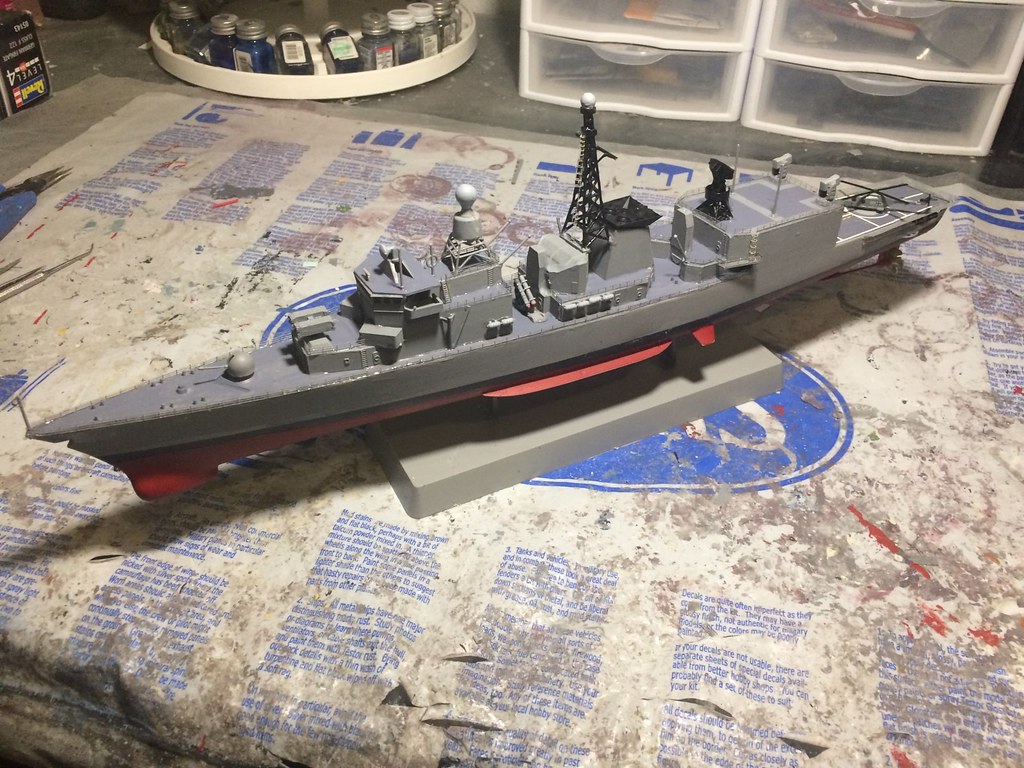
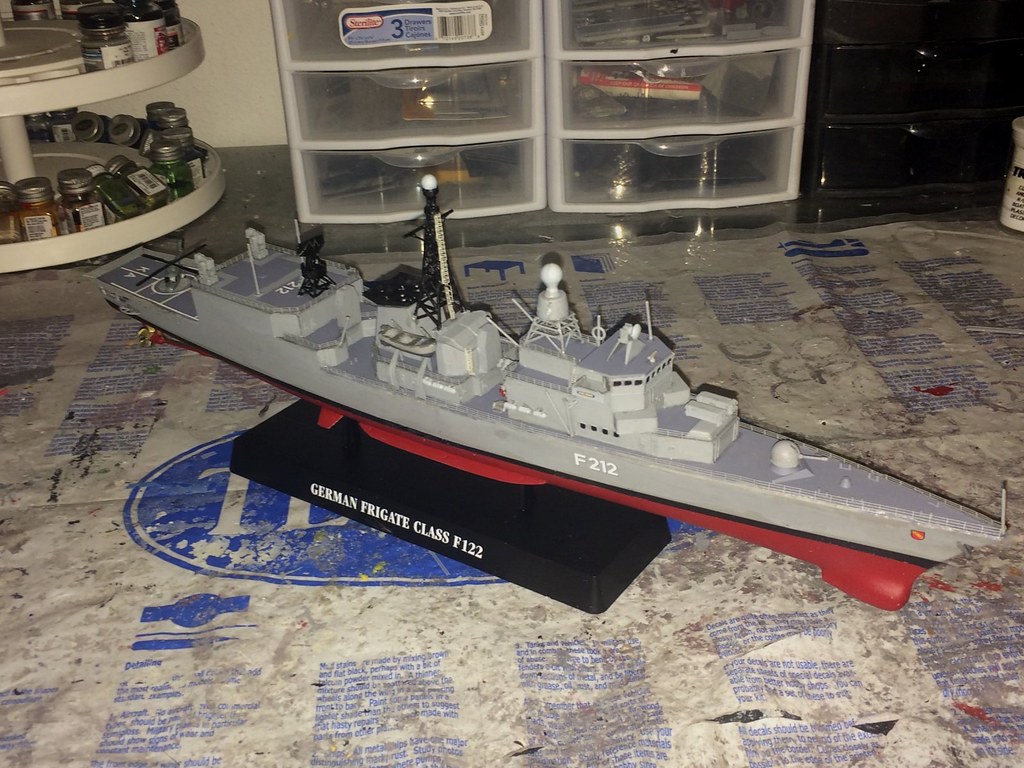
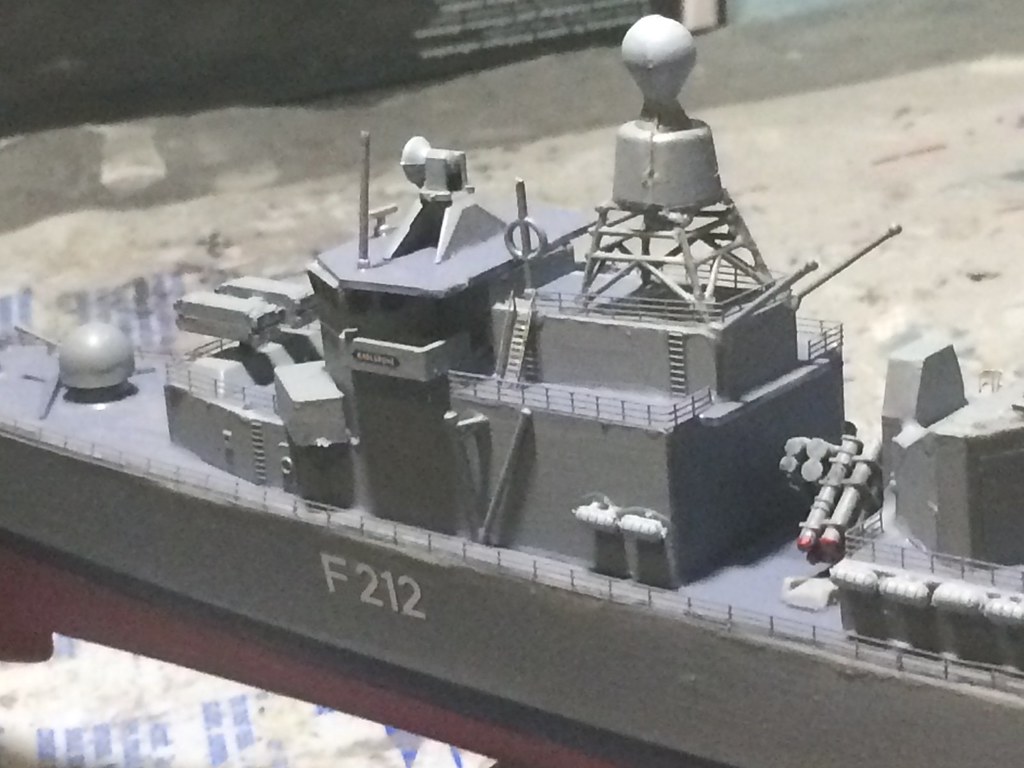
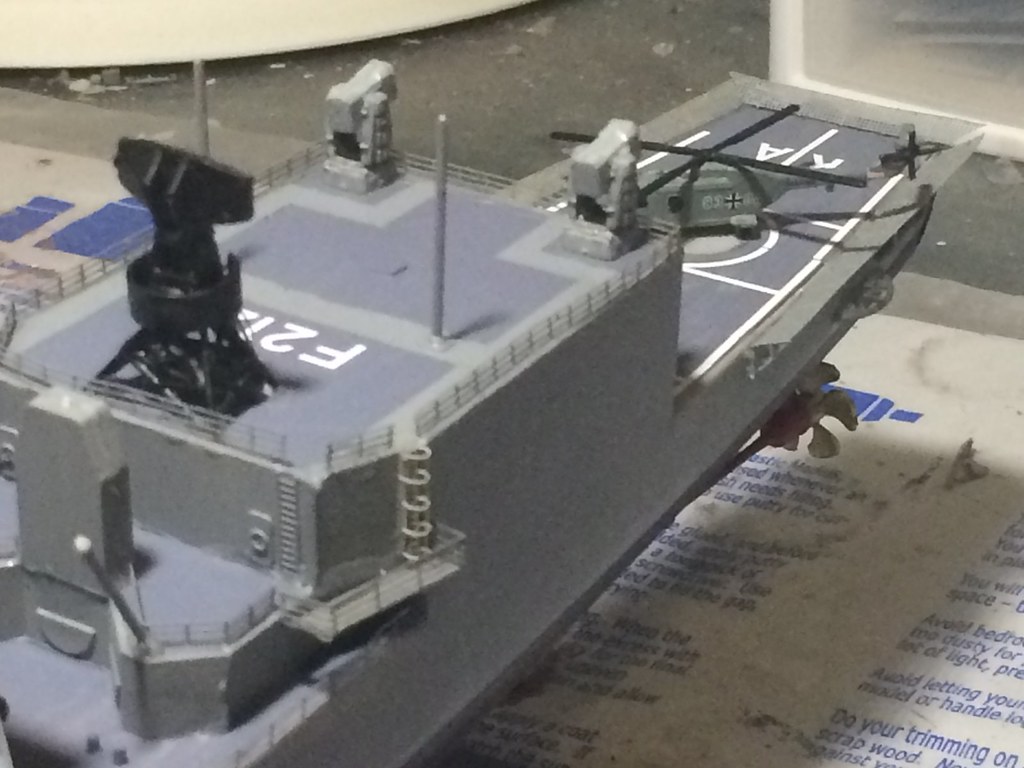
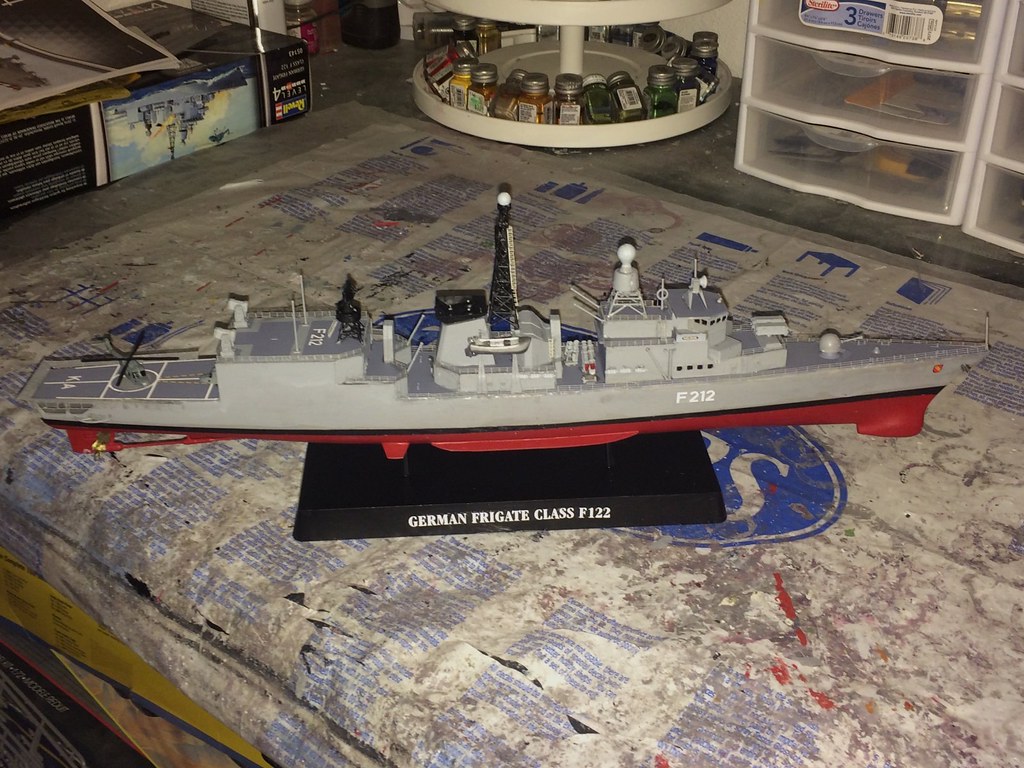
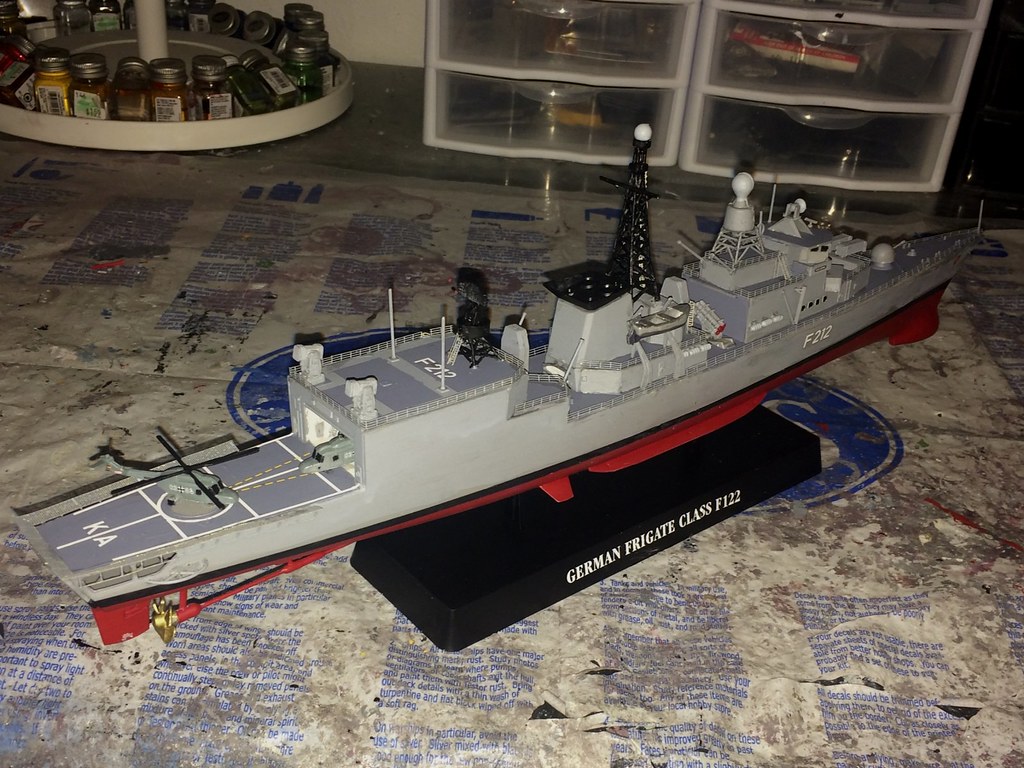
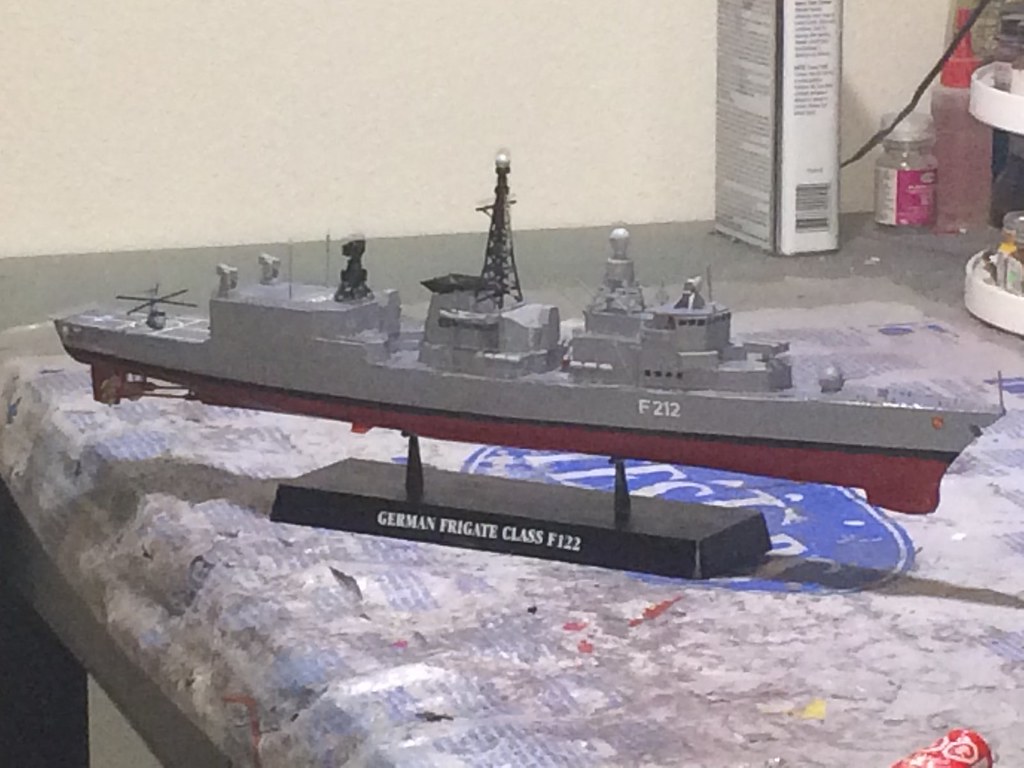
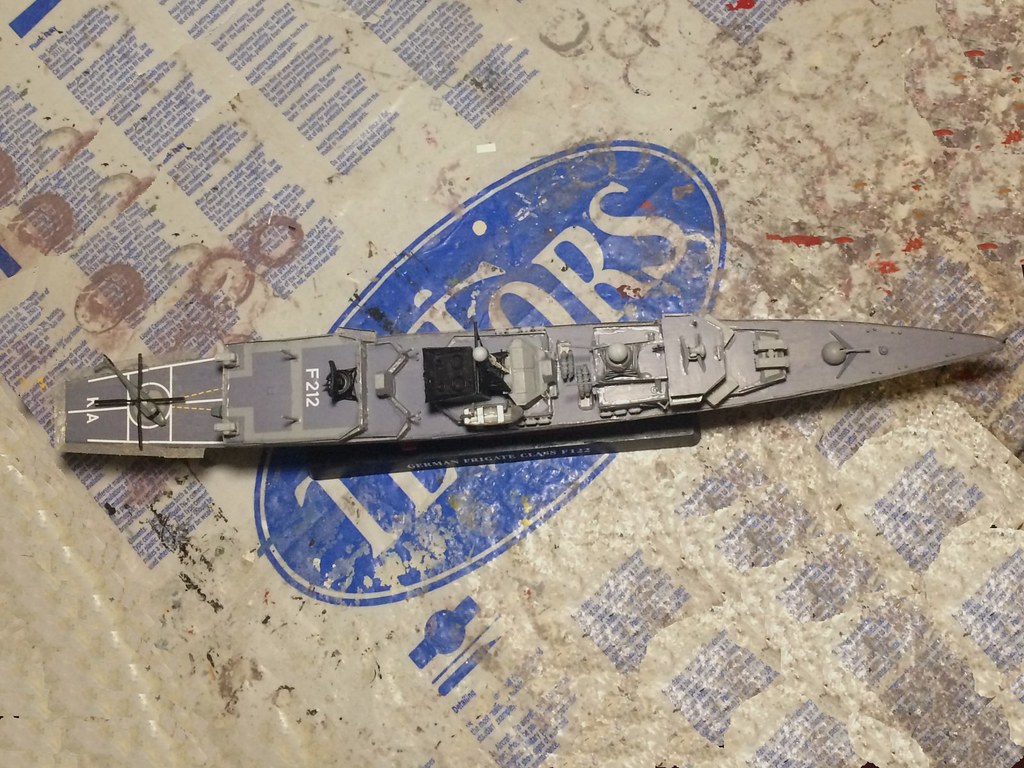
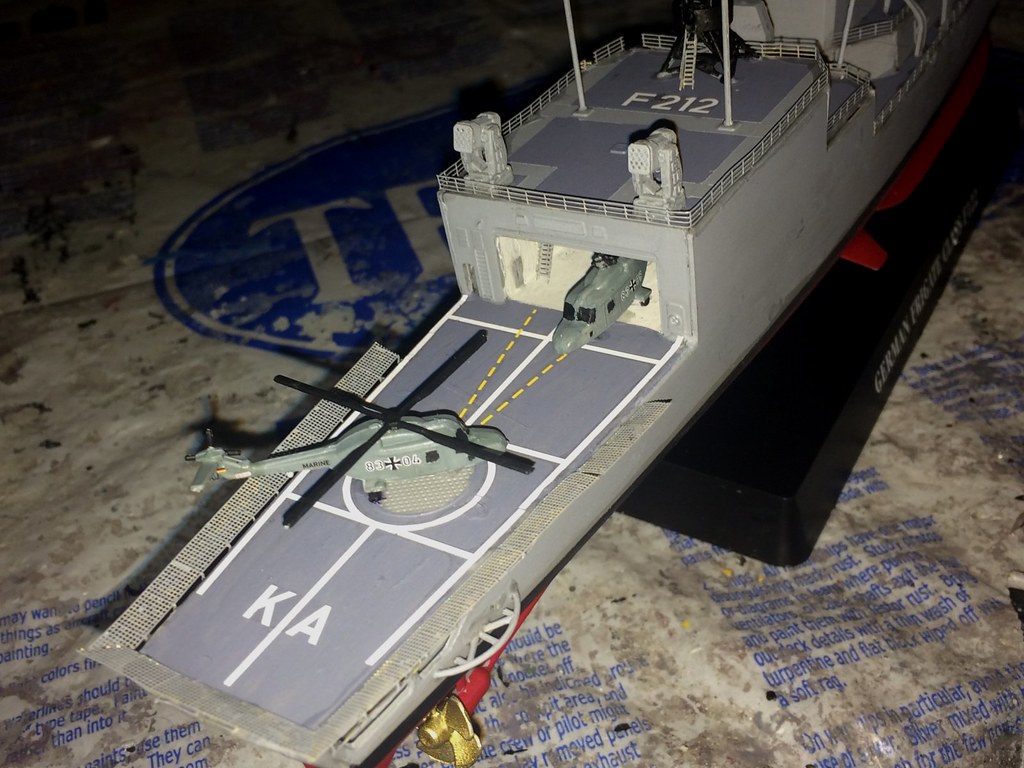
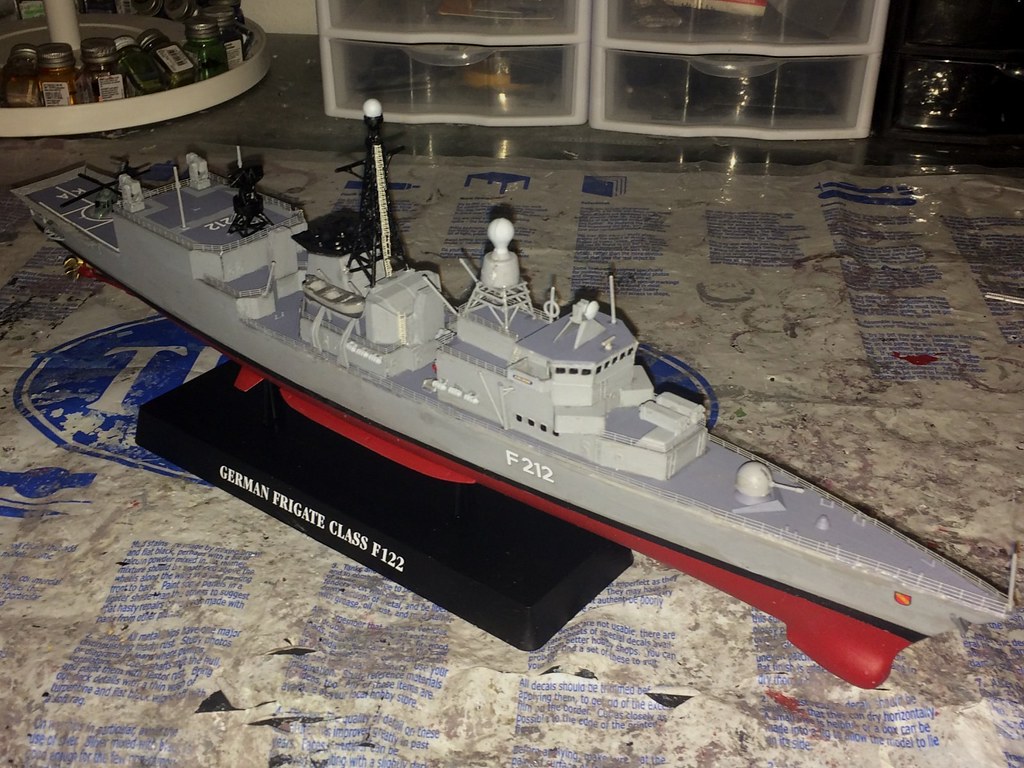
A very nice depiction if I do say so myself.
This just left the final touch up, gloss coats, and then the finished pictures:
The Build - TOuch up, and finished models: - February 21, 2017
After the dull coat pictures and painting the stand properly, here's how the completed model looks starting with the standard pictures from all quarters:
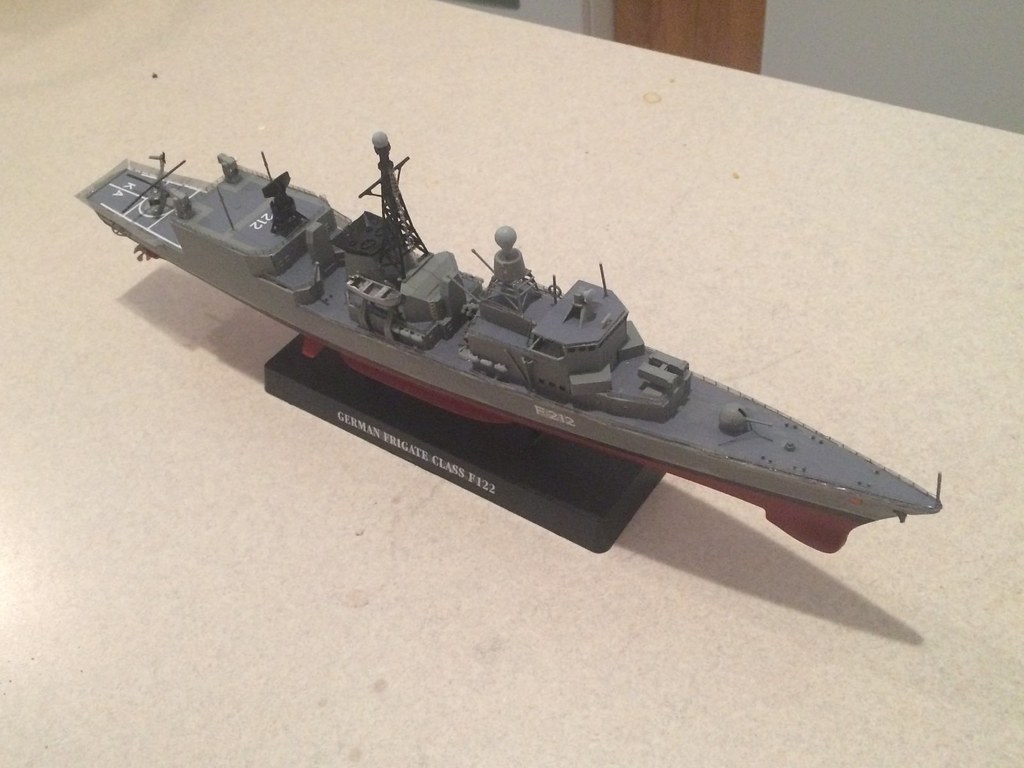
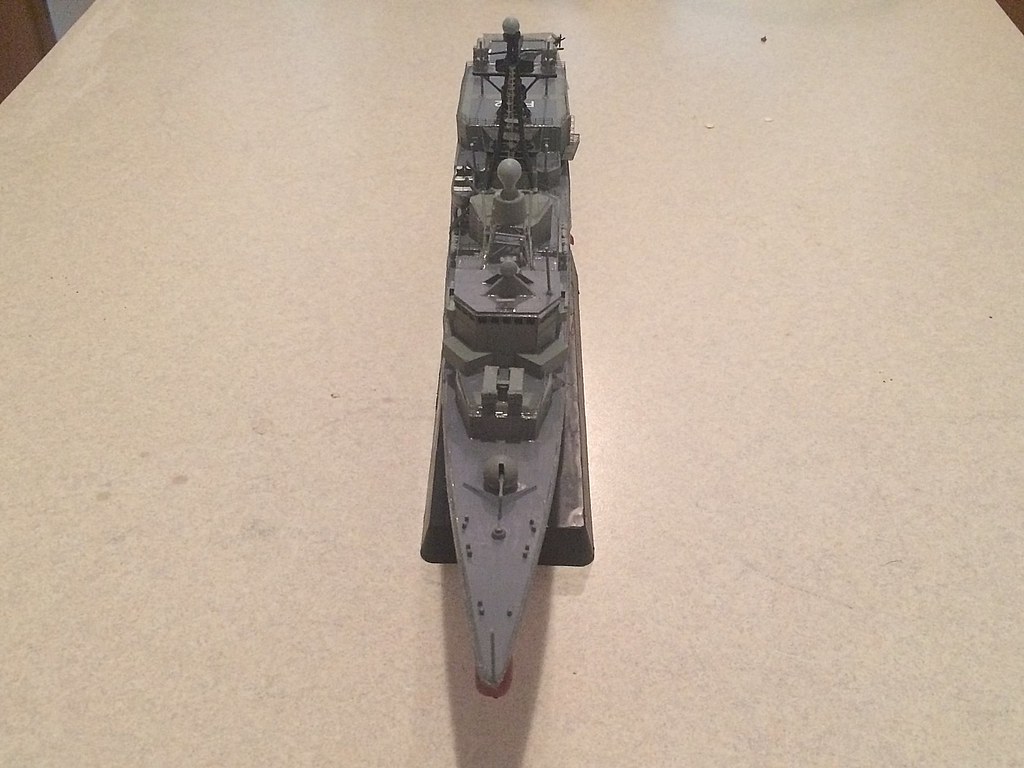
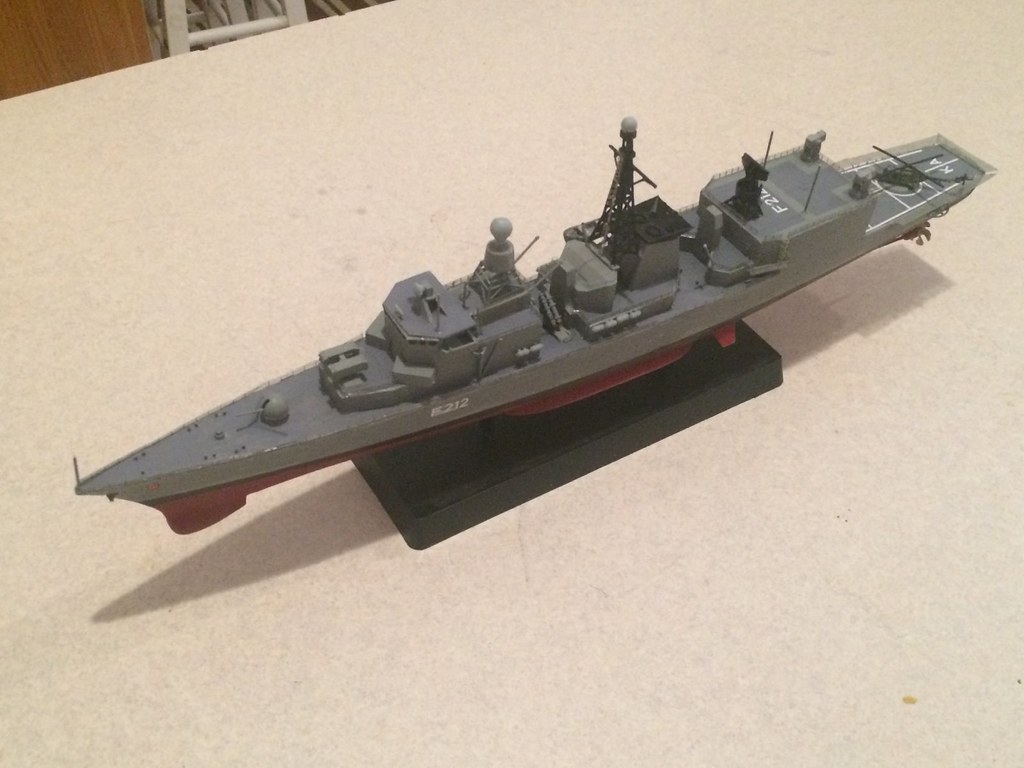
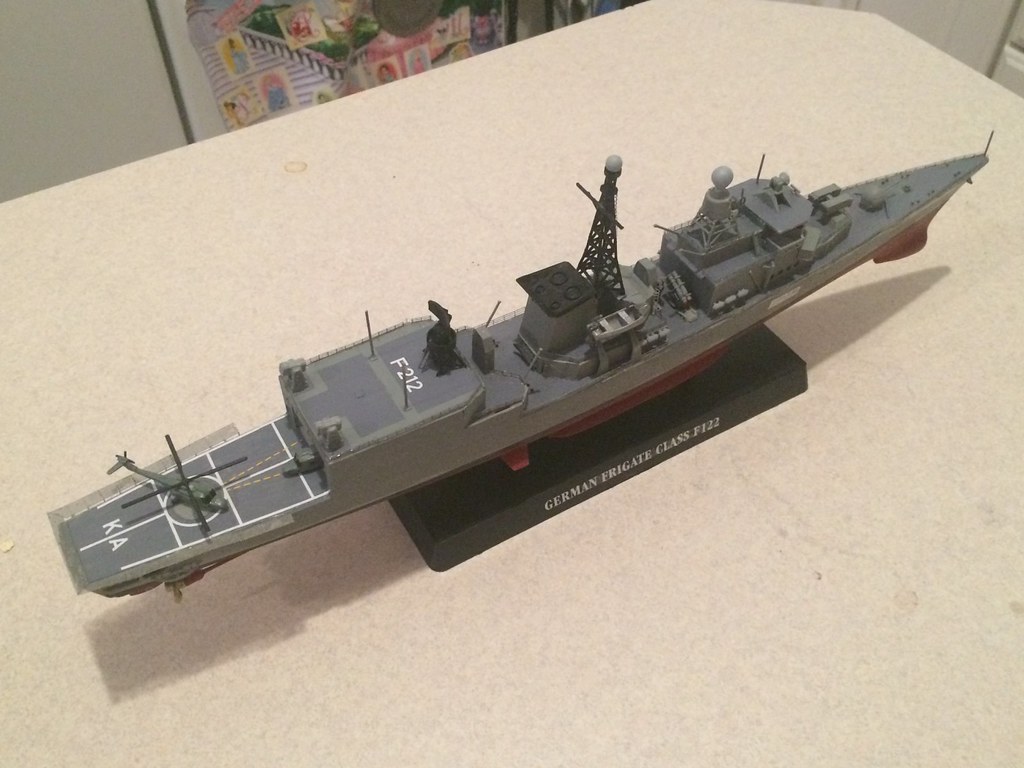
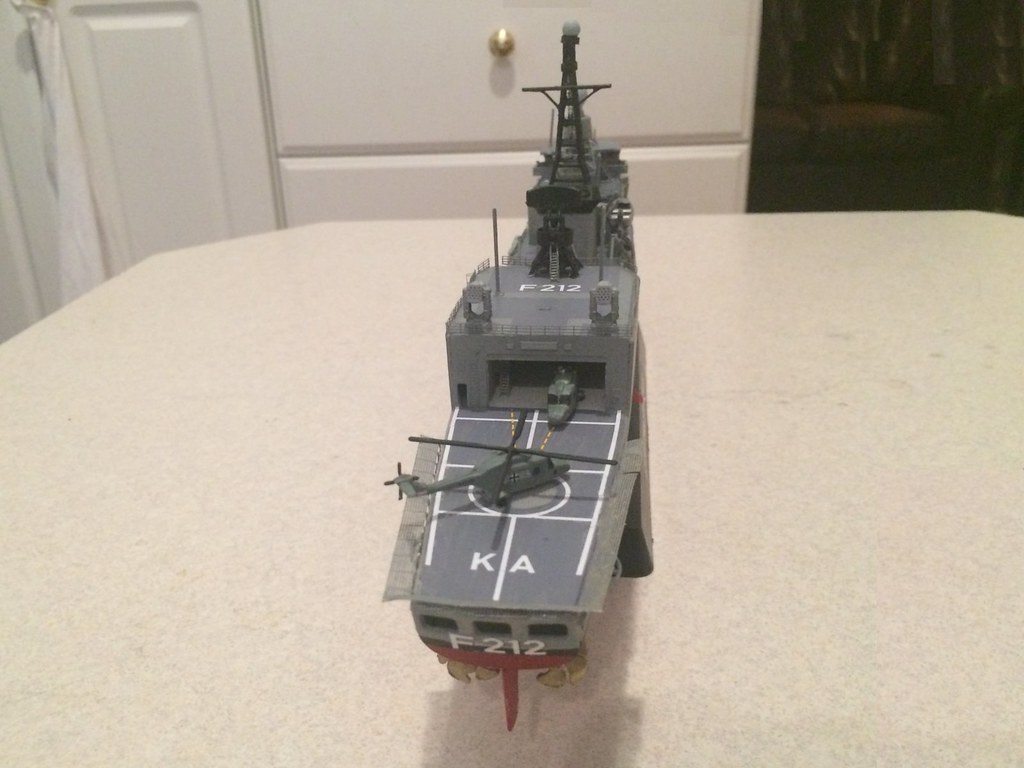
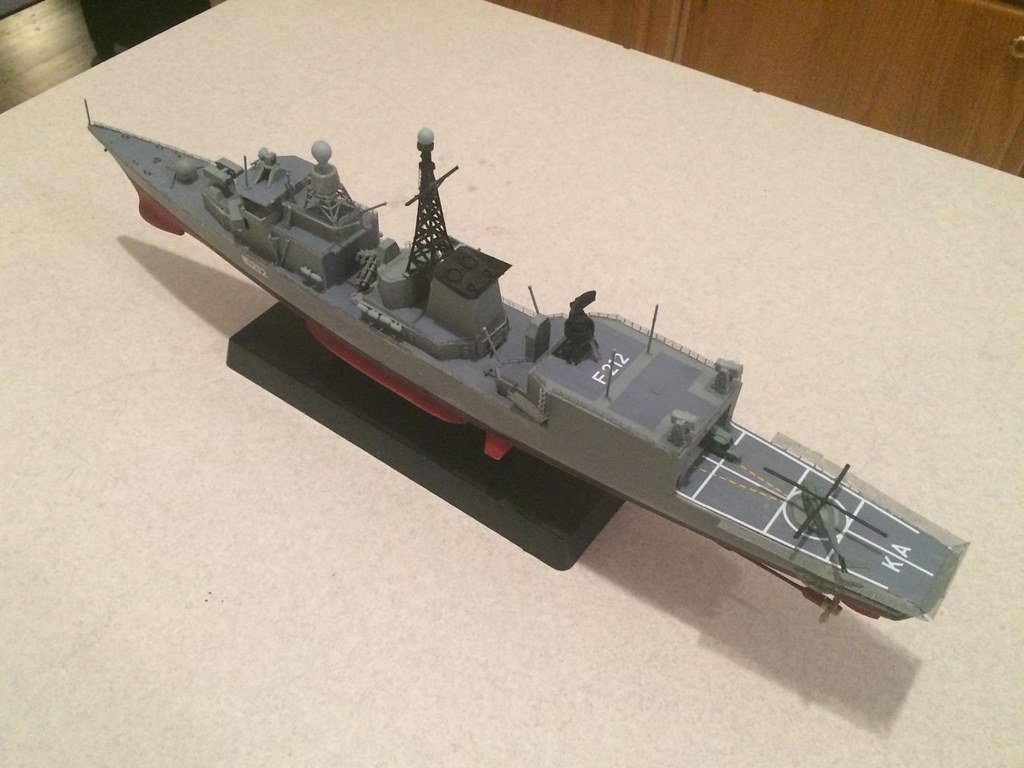
Then some close ups and details:
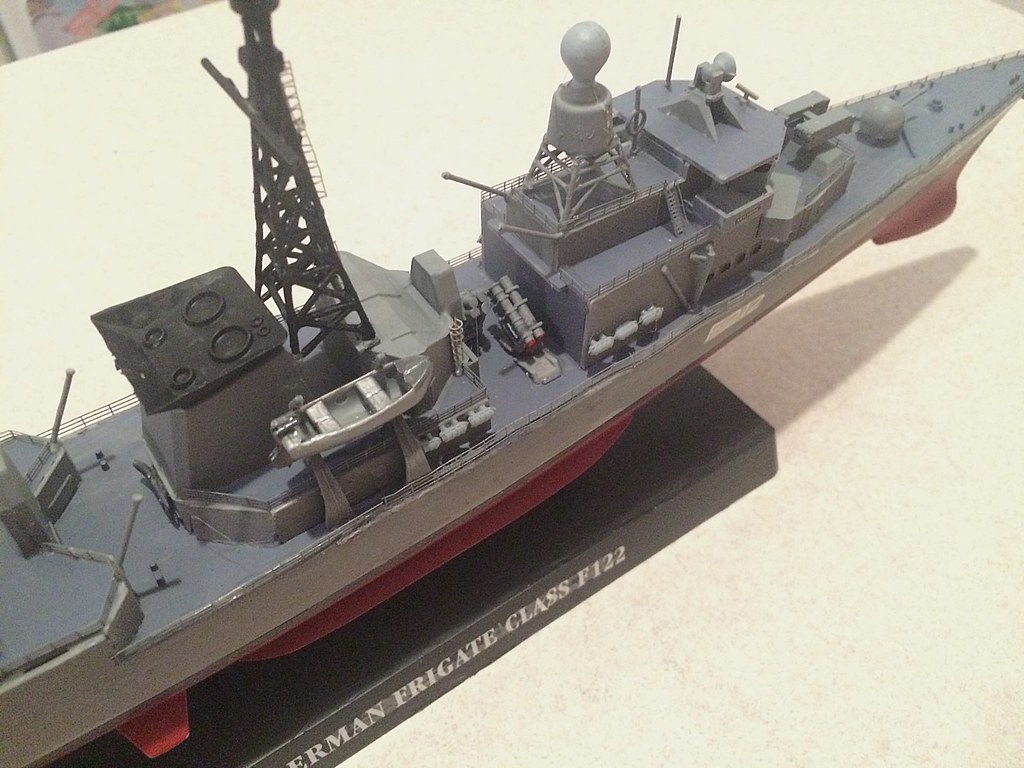
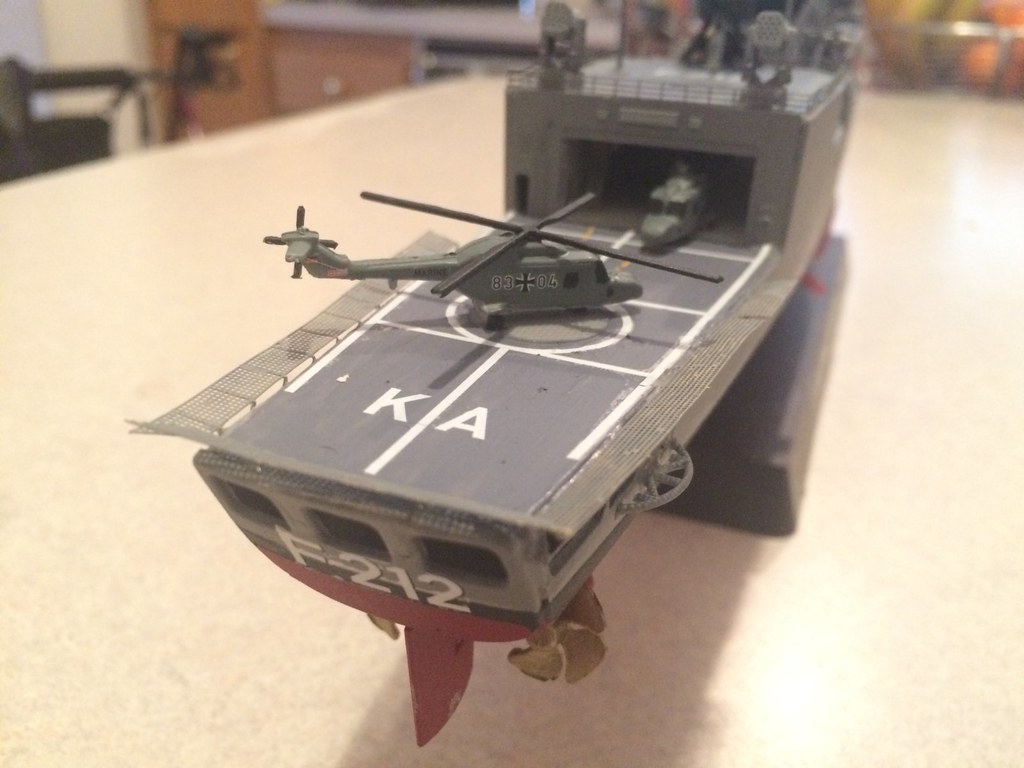
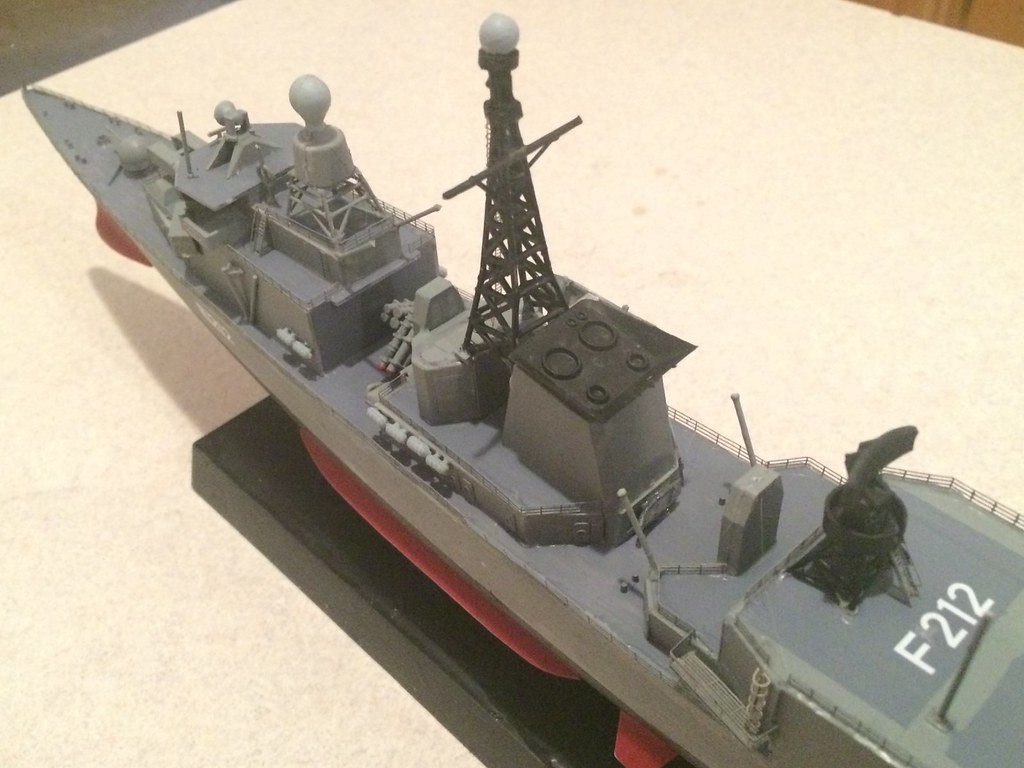
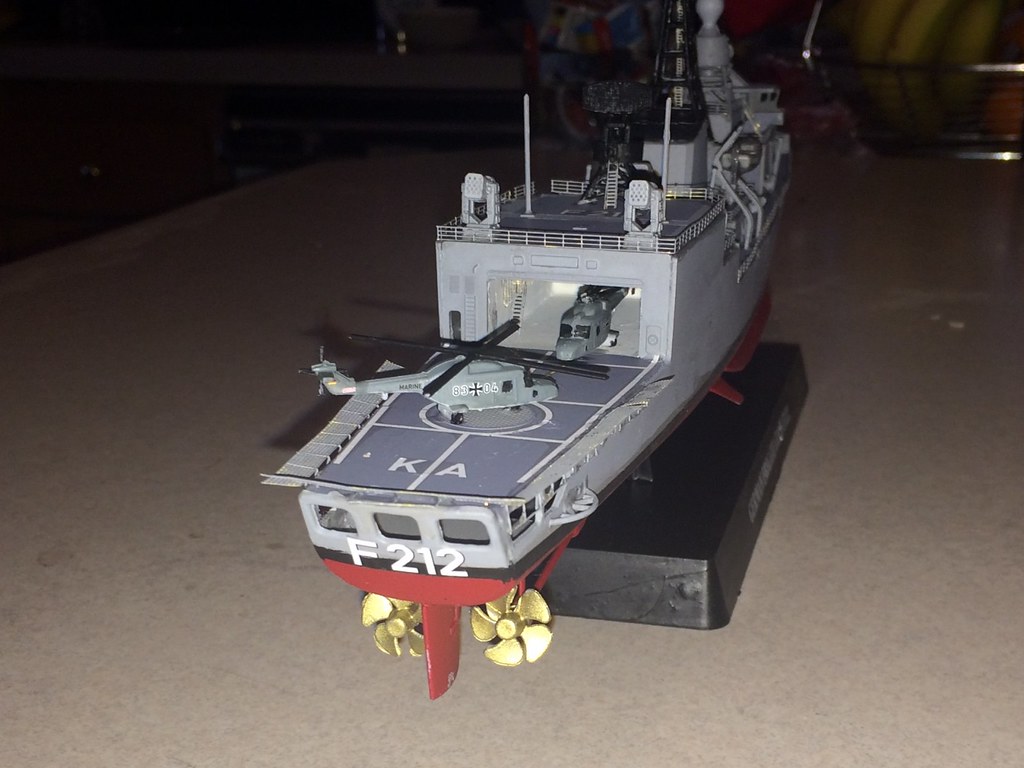
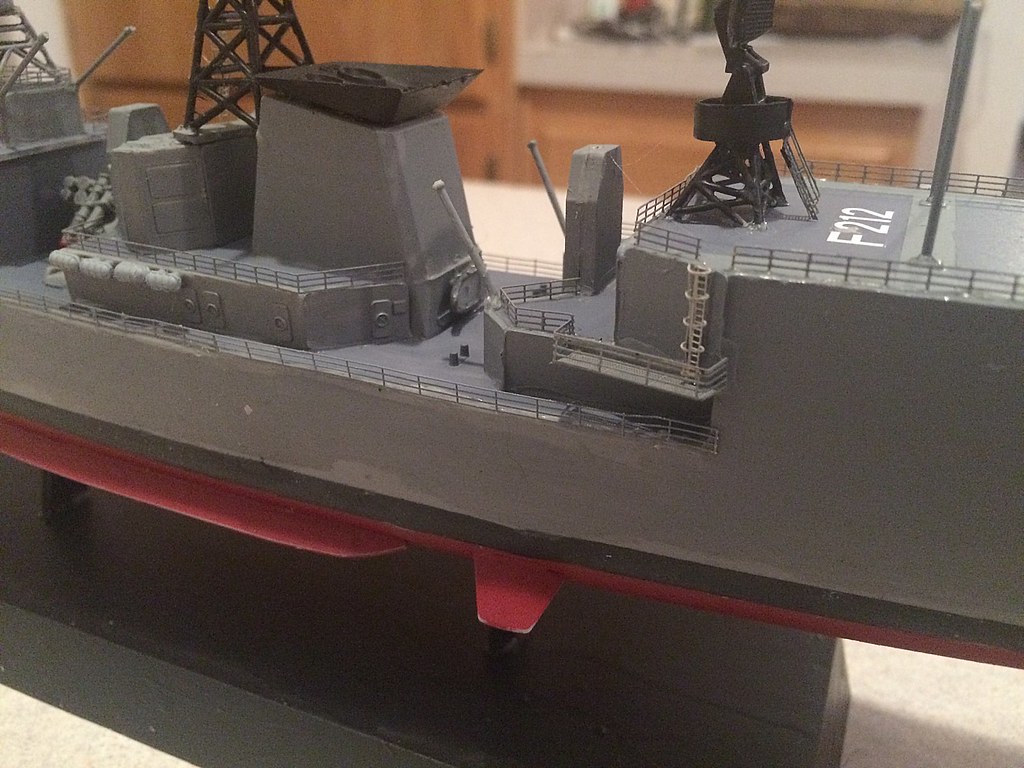
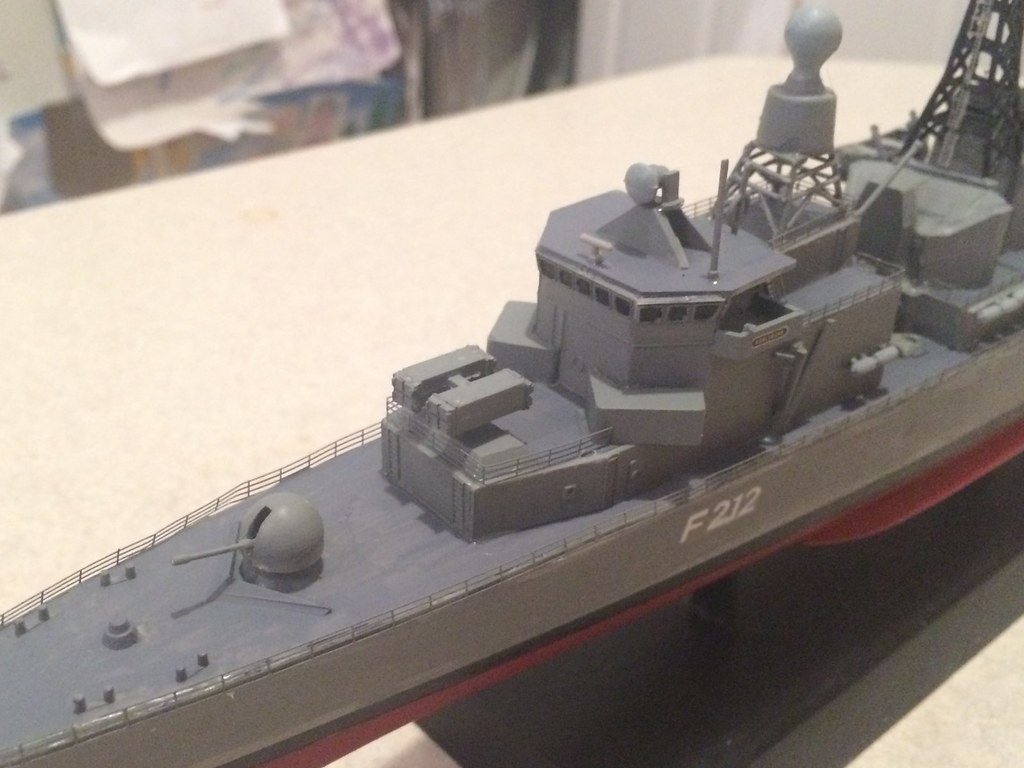
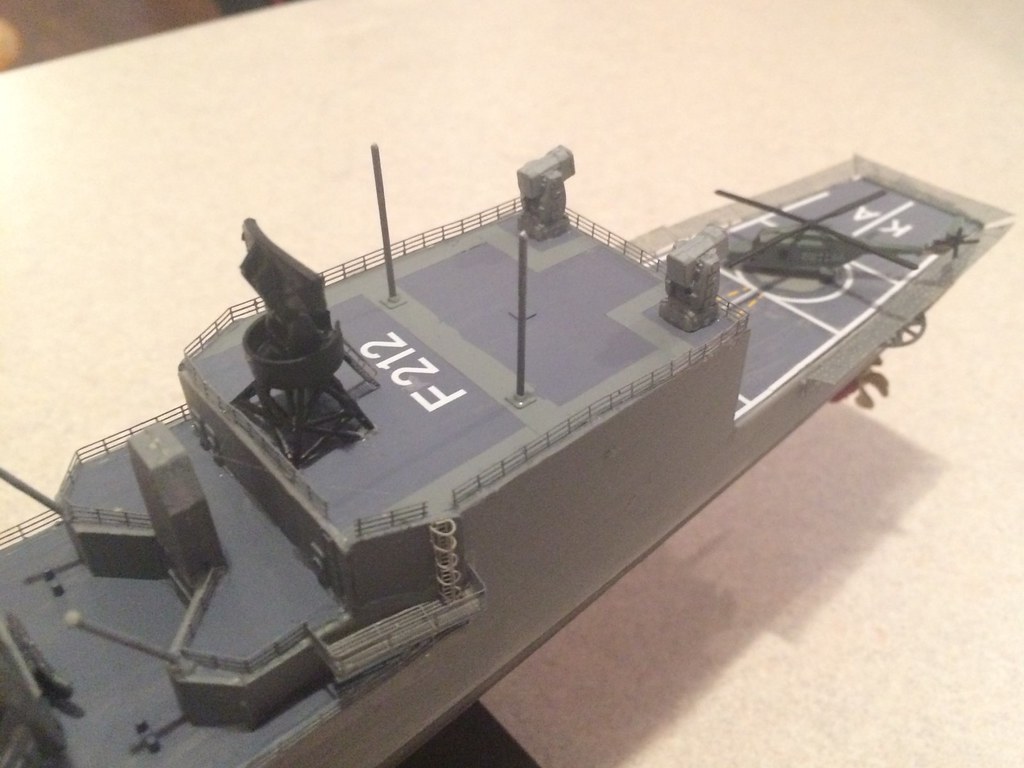
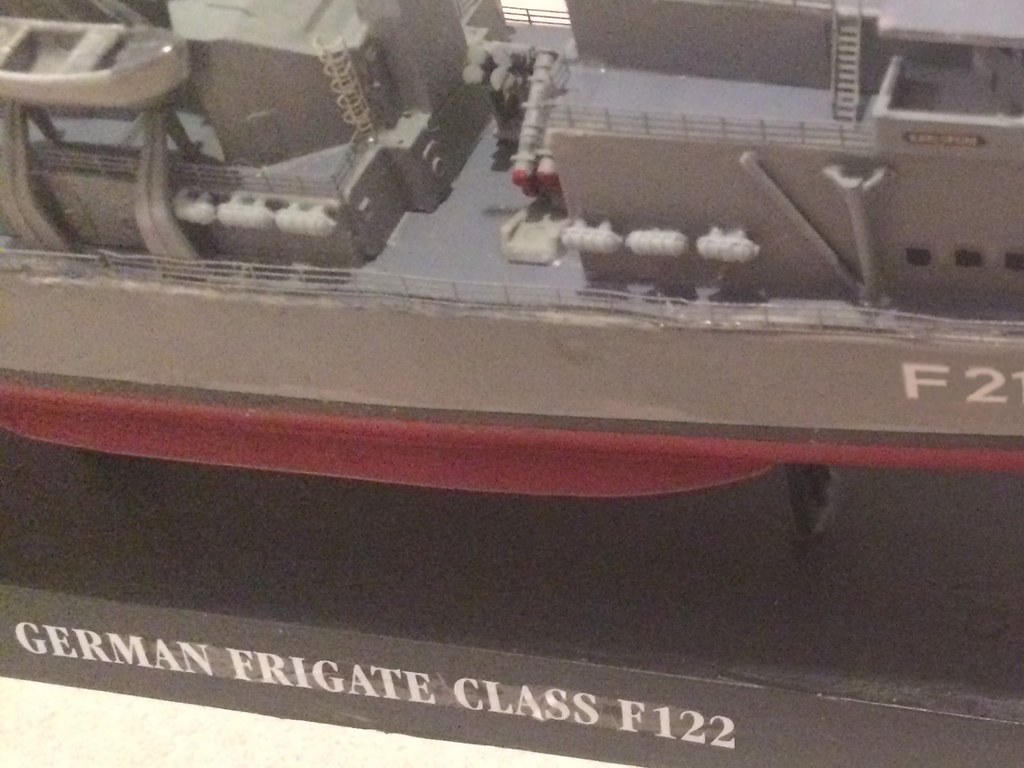
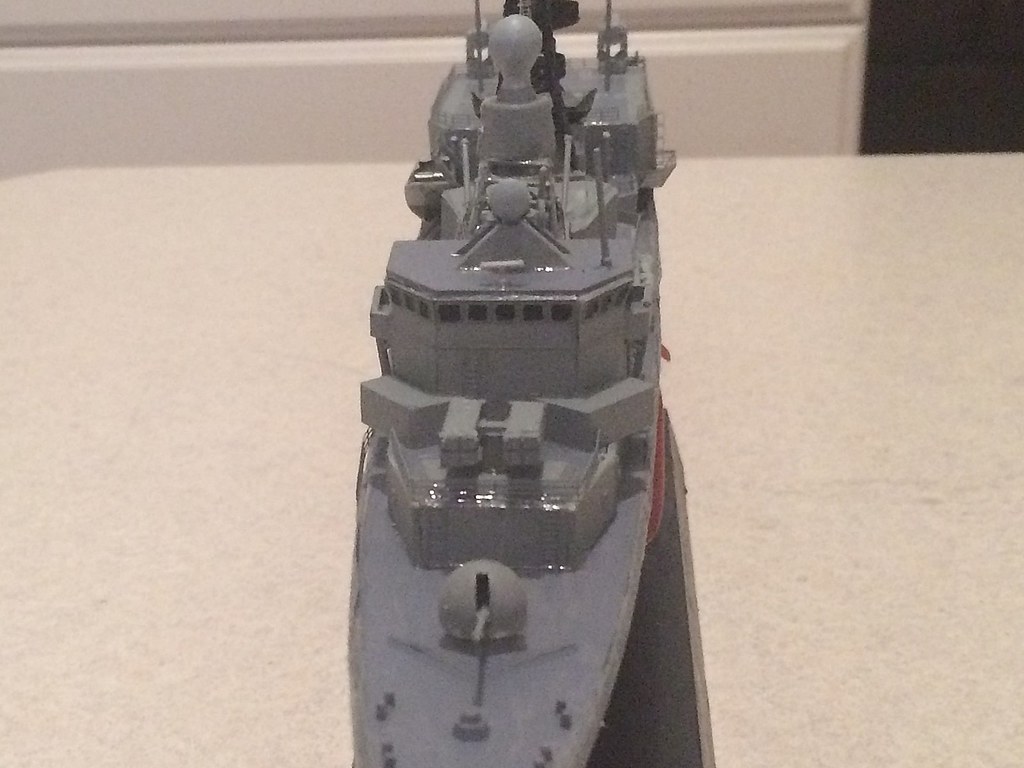
She did turn ut very nicely for a $25 dollar kit and a few extra parts.
I have a Type 212 German SSK sunmarine coming in 1/350 scale, and a 3D molded Type F125 BAden Wurtenberg frigate coming to complete a small West German grouping for my models.
The Germans build really decent vessels.
SCHEDULE for Future Activities - February 21, 2017
- By March 3, 2017 complete a German Type 212 Submarine in 1/350 scale
- By March 17, 2017 complete a German Type 125 Friagte in 1/350 scale
- By April 30th, 2017 complete hte WW II USS HOrnet in 1/350 scale
The completion of the PLAN Carrier group was centered on the already completed Trumpeter's 1/350 scale PLA Navy's Aircraft Carrier CV-16, Liaoning, (in addition to the other escorts already completed) included Mini Hobby's PLAN Guangzhou, DDG-168. I recently pre-ordered a 1/350 scale model of the PLAN Type 071 LPD, Yuzhao Class, announced by Dragon and due out in October, 2013. I will end up adding two of those, probably LPD-998 Yuzhao and LPD-999, Jinggangshan, add the PLAN- DDG-139, Ningbo, and the PLAN DDG-115, Shenyang, along with the PLAN Weifang, FFG-550 and thus build a PLAN ARG.
The completion of the US Carrier Strike group was centered on the completed Tamyia's 1/350 scale USS Enterprise, CVN-65, (in addition to the other escorts already completed) included Dragon's, USS Freedom, LCS-1, Dragon's USS Preble, DDG-88 and Hobby Boss's USS Texas, SSN-775. When a 1/350 scale USS Enterprise, CVN-80 (or any Gerald R. Ford Class) is released from Dragon, Tamiya, Dragon, or whomever else, I will add it to this group along with another AEGIS Cruiser. Whichever Ford Class coms out in 1/350 scale, I will build it as the USS Enterprise, CVN-80.
The US ARG includes Tamiya's 1/350 scale, USS Iowa, BB-62 (which I have already completed), Gallery's 1/350 scale USS Iwo Jima LHD-7, Gallery's 1/350 scale (already completed), USS New York, LPD-21 (Completed), Cyber Hobby's USS Independence, LCS-2 (Completed), Bronco Model's 1/350 scale USS Coronado, LCS-4 (Completed), a Flight IIA US AEGIS class destroyer based on Dragon's 1/350 scale USS The Sullivans, DDG-68 (Completed), a Ticonderoga AEGIS cruiser (Completed), and a 1/350 scale Orange Hobbies USS Harper's Ferry, LSD-49...all of these models which I already own.
The completion of the UK Group featured the Airfix 1/350 scale HMS Illustrious, R06 as its center piece until a 1/350 scale Queen Elizabeth carrier is released. When that happens, I will add that carrier to the group as its centerpiece. The Royal Navy CSG will also include two Airfix 1/350 scale Daring Class DDGs (one of which is already completed), two Dragon 1/350 scale Type 23 HMS Duke class Frigates (one of which is already completed), and the Hobby Boss 1/350 scale HMS Astute SSN (which is also already completed) and Airfix 1/350 scale HMS Trafalgar SSN. One day, when a 1/350 scale HMS Ocean LPD comes out, I will use it to start building a Royal Navy ARG.
The French CSG is centered on Heller's 1/400 scale Charles De Gaulle, R91. I have purchased the 1/400 scale Heller French De Grasse, D612 DDG, which is an ASW DDG, the French Aconit F713 and Gueprattet F714 Lafayette FFGs, both of which are Lafayette class frigates. These four vessels round out my French CSG and are all completed. As soon as a French Robin class nuclear sub, like the French Pearle S606 SSN is released in 1/350 or 1/400 scale, I will add that to the group. Also as soon as the Forbin D620, Horizon class anti-air DDG is released in 1/350 or 1/400 scale, I will purchase one of them for the AAW defense DDG. One day, when a Mistral Class LPD is released in 1/350 or 1/400 scale so I will create a French ARG.
The completion of the Japanese JMSDF group was centered on Fujimi's very finely detailed, 1/350 scale Hyuga, DDH-181. It will be escorted by Dragon's 1/350 scale DDG-177, Atago, an AEGIS class DDG and the JMSDF, DDG-174, Kongo class (which I own), Dragon’s 1/350 scale DDG-114 Susunami and DDG-111 (both of which are Takinami Class DDGs which I own), and by the 1/350 scale SS-503 Hakuryu (which I own), one of Japans new, very modern and capable AIP Diesel Electric submarines. It also included a Arts Technic 1/350 scale, DDG-116 Teruzuki (Akizuki class) destroyer. Should a 1/350 scale Osumi Class LPD and/or the larger 1/350 Izumo class DDH be released, I will buy those vessels and add them to the group.
Then, finally the Russian CSG (centered on Trumpeter's Kuznetsov which I own) the Russian Kirov Class nuclear battle cruiser (CGN), the Peter the Great, by Trumpeter, the Russian Slava Class cruiser, Varyag by Dragon (which I own), two Dragon 1/350 scale Udaloy DDGs (which I own), Hobby Boss's Akula II class SSN (which I own), and the new Yasen class Russian SSN (which I own), all in 1/350 scale. These are all completed as well. Sometime in the more distant future when a 1/350 scale Russian version of the French Mistral class comes out (which is building in real life right now), I will add two of those and build a Russian ARG.
Recently I purchased Heller's 1/400 scale Foch, the Clemenceau Class carrier that was sold to the Brazilians in 2000 and in 2002 was refitted and became the Brazilian CV, Sao Paulo, using steam catapults. I will build the model as the Sao Paulo and thus start a Brazilian group, though the Type 22 DDGs and the FFGs the Brazilians use are not available at present. I have however purchased a set of 1/400 scale A-4 Skyhawks and S-3 Trackers to build a suitable air wing for the Sao Paulo.
Then, again, once the models are available, I'd like to build an Italian Carrier Strike Group centered on the Cavour and their Horizon DDGs, a Spanish Carrier Strike Group centered on the Juan Carlos and their F-100 AEGIS FFGs, and ultimately an Australian Strike Group centered on the new Canberra Class LPD and the Hobart class AEGIS DDGs. If they ever build the models, an Indian Carrier Strike Group centered on either the Vikramaditya or their new ADS Carrier, the Vikrant, and their Kolkata class DDGs and Shivlak class FFGs would also be nice.
Years more worth of work!
You can see all of these actual carriers, read their histories and specifications at my site:
WORLD-WIDE AIRCRAFT CARRIERS